UNITED STATES
SECURITIES AND EXCHANGE COMMISSION
WASHINGTON, D.C. 20549
FORM 8-K
CURRENT REPORT
Pursuant to Section 13 or 15(d) of the Securities Exchange Act of 1934
Date of Report (Date of earliest event reported): March 24, 2025 |
Larimar Therapeutics, Inc.
(Exact name of Registrant as Specified in Its Charter)
Delaware |
001-36510 |
20-3857670 |
||
(State or Other Jurisdiction |
(Commission File Number) |
(IRS Employer |
||
|
|
|
|
|
Three Bala Plaza East |
|
|||
Bala Cynwyd, Pennsylvania |
|
19004 |
||
(Address of Principal Executive Offices) |
|
(Zip Code) |
||
Registrant’s Telephone Number, Including Area Code: (844) 511-9056 |
|
(Former Name or Former Address, if Changed Since Last Report)
Check the appropriate box below if the Form 8-K filing is intended to simultaneously satisfy the filing obligation of the registrant under any of the following provisions:
Securities registered pursuant to Section 12(b) of the Act:
|
|
Trading |
|
|
Common Stock, par value $0.001 per share |
|
LRMR |
|
Nasdaq Global Market |
Indicate by check mark whether the registrant is an emerging growth company as defined in Rule 405 of the Securities Act of 1933 (§ 230.405 of this chapter) or Rule 12b-2 of the Securities Exchange Act of 1934 (§ 240.12b-2 of this chapter).
Emerging growth company ☐
If an emerging growth company, indicate by check mark if the registrant has elected not to use the extended transition period for complying with any new or revised financial accounting standards provided pursuant to Section 13(a) of the Exchange Act. ☐
Item 2.02 Results of Operations and Financial Condition.
On March 24, 2025, Larimar Therapeutics, Inc. (the “Company”) announced its financial results and operational highlights for the fourth quarter of 2024 and for the year ended December 31, 2024. A copy of the press release is being furnished as Exhibit 99.1 to this Current Report on Form 8-K and is incorporated herein by reference.
The information furnished pursuant to this Item 2.02, including Exhibit 99.1 attached hereto, is intended to be furnished and shall not be deemed “filed” for purposes of Section 18 of the Securities Exchange Act of 1934, as amended (the “Exchange Act”), or otherwise subject to the liabilities of that section, nor shall it be deemed incorporated by reference in any filing under the Securities Act of 1933, as amended, or the Exchange Act, except as expressly set forth by specific reference in such filing.
Item 8.01 Other Events.
On March 24, 2025, the Company posted on its website an updated slide presentation, which is attached as Exhibit 99.2 to this Current Report on Form 8-K and is incorporated herein by reference. Representatives of the Company will use the presentation in various meetings with investors, analysts and other parties from time to time.
Item 9.01 Financial Statements and Exhibits.
(d) Exhibits
Below is a list of exhibits included with this Current Report on Form 8-K.
Exhibit No. |
|
Document |
99.1 |
|
Press Release issued by Larimar Therapeutics, Inc. on March 24, 2025* |
99.2 |
|
Larimar Therapeutics, Inc. Corporate Presentation, dated March 24, 2025 |
104 |
|
Cover Page Interactive Data File (embedded within the Inline XBRL document) |
* Furnished herewith.
SIGNATURES
Pursuant to the requirements of the Securities Exchange Act of 1934, the registrant has duly caused this report to be signed on its behalf by the undersigned hereunto duly authorized.
|
|
|
Larimar Therapeutics, Inc. |
|
|
|
|
Date: |
March 24, 2025 |
By: |
/s/ Carole S. Ben-Maimon, M.D. |
|
|
|
Name: Carole S. Ben-Maimon, M.D. |
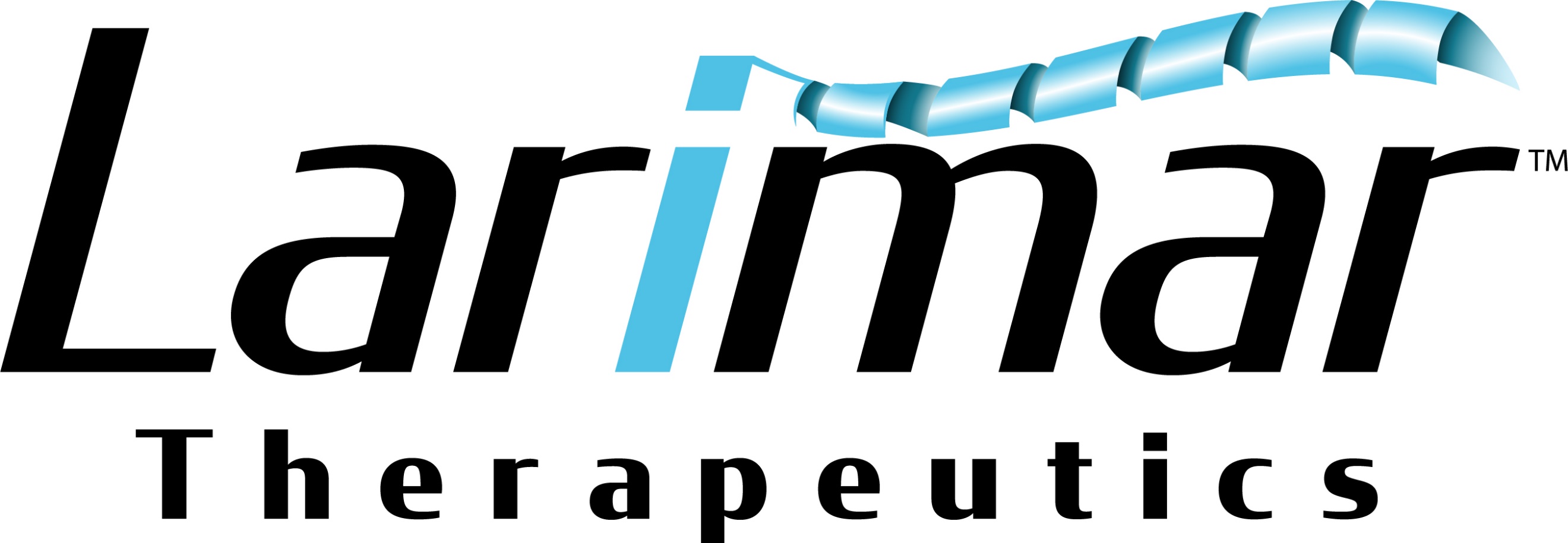
Exhibit 99.1
Larimar Therapeutics Provides Nomlabofusp Development Update and Reports Fourth Quarter and Full Year 2024 Financial Results
Bala Cynwyd, PA, March 24, 2025 – Larimar Therapeutics, Inc. (Larimar) (Nasdaq: LRMR), a clinical-stage biotechnology company focused on developing treatments for complex rare diseases, today reported its fourth quarter and full year 2024 operating and financial results.
“The strong clinical and regulatory progress across our nomlabofusp program reinforces the timing of our planned Biologics License Application (BLA) submission expected by the end of 2025 to seek accelerated approval. Importantly, we are enthusiastic about the recent FDA interactions and their openness to consider skin frataxin (FXN) concentrations as a potential novel surrogate endpoint reasonably likely to predict clinical benefit in patients with Friedreich’s ataxia (FA). Acceptability of FXN as a novel surrogate endpoint will be based on review of the data by the Food and Drug Administration (FDA) in the future BLA. As we previously disclosed, we have been collecting skin FXN concentration data throughout the development program,” said Carole Ben-Maimon, MD, President, and Chief Executive Officer of Larimar. “Overall, FDA’s recommendations are in line with our current approach, and we appreciate the frequent dialogue via our participation in the Support for Clinical Trials Advancing Rare Disease Therapeutics (START) pilot program as we further refine our registrational plan.”
Dr. Ben-Maimon continued, “Our open label extension (OLE) study continues to advance, with some participants on daily treatment for up to one year. We continue to actively enroll study participants, and all participants are currently receiving the 50 mg dose. The 25 mg initial data we presented in December showed increased and sustained FXN levels over time and early trends in improved clinical outcomes in patients with FA. Our pediatric pharmacokinetic (PK) run-in study continues to progress, and we expect to complete the dosing of the adolescent cohort by the end of this month and report available data in September 2025. We also plan to enroll children 2-11 years of age in the clinical program. We have received feedback from both FDA and European Medicines Agency (EMA) on the protocol for our global Phase 3 trial and are on track to initiate this trial mid-2025. We believe our near-term data package strongly positions us to bring the first potential disease modifying therapy to patients with FA.”
Recent Highlights
Fourth Quarter and Full Year 2024 Financial Results
As of December 31, 2024, the Company had cash, cash equivalents and marketable securities totaling $183.5 million.
The Company reported a net loss for the fourth quarter of 2024 of $28.8 million, or $0.45 per share, compared to a net loss of $13.0 million, or $0.30 per share, for the fourth quarter of 2023.
Research and development expenses for the fourth quarter of 2024 were $26.7 million compared to $10.6 million for the fourth quarter of 2023. The increase in research and development expenses was primarily driven by an increase of $15.0 million in nomlabofusp manufacturing costs including lyophilization development, production scaling costs and manufacturing costs related to producing doses to be used in ongoing and planned clinical trials, an increase of $1.3 million in personnel expense due to increased headcount, an increase of $1.0 million of professional fees related to consulting costs, and an increase of $0.5 million in stock compensation costs associated with 2024 grants, partially offset by a decrease of $1.7 million in clinical trial costs primarily associated with decreased activity in the dose exploration study in 2024.
General and administrative expenses for the fourth quarter of 2024 were $4.6 million compared to $3.5 million for the fourth quarter of 2023. The increase in general and administrative expenses was primarily driven by an increase of $0.6 million in professional fees primarily related to consulting costs related to commercial activity and other public company related expenses, and an increase of $0.4 million in personnel expense due to increased headcount.
Other income (expense), net was $2.5 million of income in the three months ended December 31, 2024 compared to $1.2 million of income in the three months ended December 31, 2023. The increase primarily relates to interest income on a higher investment base and higher investment yields on that base during the current period.
For the full year 2024, the Company reported a net loss of $80.6 million, or $1.32 per share, compared to a net loss of $36.9 million, or $0.84 per share, for the same period in 2023.
Research and development expenses for the full year 2024 were $73.3 million compared to $27.7 million for the same period in 2023. The increase in research and development expenses was primarily driven by an increase of $36.1 million in nomlabofusp manufacturing costs including lyophilization development, production scaling costs and manufacturing costs related to producing doses to be used in ongoing and planned clinical trials, an increase of $4.5 million in personnel expense due to increased headcount, an increase of $1.3 million of professional fees related to consulting costs, an increase of $1.2 million in clinical costs primarily associated with the ongoing OLE study which began dosing participants in the first quarter of 2024, an increase of $1.0 million in stock compensation costs associated with 2024 equity compensation grants, an increase of $0.9 million related to the Friedreich’s Ataxia Research Alliance (FARA) Track-FA program, an increase of $0.3 million in internal lab costs and an increase of $0.2 million in facility costs associated with the new lab space.
General and administrative expenses for the full year 2024 were $17.6 million compared to $14.1 million for 2023. The increase in general and administrative expenses was primarily driven by an increase of $1.5 million in professional fees primarily related to consulting costs related to commercial activity and other public company related expenses, an increase of $1.4 million in personnel expense due to increased headcount, an increase of $0.4 million of other expense related to computer software, information technology services and recruiting and an increase of $0.2 million in stock compensation costs associated with 2024 equity compensation grants.
Other income (expense), net was $10.3 million of income in the twelve months ended December 31, 2024 compared to $4.8 million of income in the twelve months ended December 31, 2023. The increase primarily relates to increased interest income on a higher investment base and higher investment yields on that base during 2024.
About Larimar Therapeutics
Larimar Therapeutics, Inc. (Nasdaq: LRMR), is a clinical-stage biotechnology company focused on developing treatments for complex rare diseases. Larimar’s lead compound, nomlabofusp, is being developed as a potential treatment for Friedreich's ataxia. Larimar also plans to use its intracellular delivery platform to design other fusion proteins to target additional rare diseases characterized by deficiencies in intracellular bioactive compounds. For more information, please visit: https://larimartx.com.
Forward-Looking Statements
This press release contains forward-looking statements that are based on Larimar’s management’s beliefs and assumptions and on information currently available to management. All statements contained in this release other than statements of historical fact are forward-looking statements, including but not limited to statements regarding Larimar’s ability to develop and commercialize nomlabofusp and any other planned product candidates, Larimar’s planned research and development efforts, including the timing of its nomlabofusp clinical trials, interactions and filings with the FDA, expectations regarding potential for accelerated approval or accelerated access and time to market and overall development plans and other matters regarding Larimar’s business strategies, ability to raise capital, use of capital, results of operations and financial position, and plans and objectives for future operations.
In some cases, you can identify forward-looking statements by the words “may,” “will,” “could,” “would,” “should,” “expect,” “intend,” “plan,” “anticipate,” “believe,” “estimate,” “predict,” “project,” “potential,” “continue,” “ongoing” or the negative of these terms or other comparable terminology, although not all forward-looking statements contain these words. These statements involve risks, uncertainties and other factors that may cause actual results, performance, or achievements to be materially different from the information expressed or implied by these forward-looking statements. These risks, uncertainties and other factors include, among others, the success, cost and timing of Larimar’s product development activities, nonclinical studies and clinical trials, including nomlabofusp clinical milestones and continued interactions with the FDA; that preliminary clinical trial results may differ from final clinical trial results, that earlier non-clinical and clinical data and testing of nomlabofusp may not be predictive of the results or success of later clinical trials, and assessments; delays in patient recruitment, including as a result of changes in clinical protocols and adverse events; that the FDA may not ultimately agree with Larimar’s nomlabofusp development strategy; the potential impact of public health crises on Larimar’s future clinical trials, manufacturing, regulatory, nonclinical study timelines and operations, and general economic conditions; Larimar’s ability and the ability of third-party manufacturers Larimar engages, to optimize and scale nomlabofusp’s manufacturing process; Larimar’s ability to obtain regulatory approvals for nomlabofusp and future product candidates; Larimar’s ability to develop sales and marketing capabilities, whether alone or with potential future collaborators, and to successfully commercialize any approved product candidates; Larimar’s ability to raise the necessary capital to conduct its product development activities; and other risks described in the filings made by Larimar with the Securities and Exchange Commission (SEC), including but not limited to Larimar’s periodic reports, including the annual report on Form 10-K, quarterly reports on Form 10-Q and current reports on Form 8-K, filed with or furnished to the SEC and available at www.sec.gov. These forward-looking statements are based on a combination of facts and factors currently known by Larimar and its projections of the future, about which it cannot be certain. As a result, the forward-looking statements may not prove to be accurate. The forward-looking statements in this press release represent Larimar’s management’s views only as of the date hereof. Larimar undertakes no obligation to update any forward-looking statements for any reason, except as required by law.
|
Investor Contact: Joyce Allaire LifeSci Advisors jallaire@lifesciadvisors.com (212) 915-2569 |
Company Contact: Michael Celano Chief Financial Officer mcelano@larimartx.com (484) 414-2715 |
|
Larimar Therapeutics, Inc. |
||||
|
Consolidated Balance Sheets
|
||||
|
|
December 31, |
|
December 31, |
|
|
2024 |
|
2023 |
Assets |
|
|
|
|
Current assets: |
|
|
|
|
Cash and cash equivalents |
|
$ 33,218 |
|
$ 26,749 |
Marketable securities |
|
150,236 |
|
60,041 |
Prepaid expenses and other current assets |
|
11,850 |
|
3,385 |
Total current assets |
|
195,304 |
|
90,175 |
Property and equipment, net |
|
881 |
|
684 |
Operating lease right-of-use assets |
|
2,838 |
|
3,078 |
Restricted cash |
|
606 |
|
1,339 |
Other assets |
|
596 |
|
659 |
Total assets |
|
$ 200,225 |
|
$ 95,935 |
Liabilities and Stockholders’ Equity |
|
|
|
|
Current liabilities: |
|
|
|
|
Accounts payable |
|
$ 2,424 |
|
$ 1,283 |
Accrued expenses |
|
20,872 |
|
7,386 |
Operating lease liabilities, current |
|
1,060 |
|
837 |
Total current liabilities |
|
24,356 |
|
9,506 |
Operating lease liabilities |
|
4,057 |
|
4,709 |
Total liabilities |
|
28,413 |
|
14,215 |
Commitments and contingencies (See Note 8) |
|
|
|
|
Stockholders’ equity: |
|
|
|
|
Preferred stock; $0.001 par value per share; 5,000,000 shares authorized as of December 31, 2024 and December 31, 2023; no shares issued and outstanding as of December 31, 2024 and December 31, 2023 |
|
— |
|
— |
Common stock, $0.001 par value per share; 115,000,000 shares authorized as of December 31, 2024 and December 31, 2023; 63,815,065 and 43,909,069 shares issued and outstanding as of December 31, 2024 and December 31, 2023, respectively |
|
64 |
|
43 |
Additional paid-in capital |
|
440,758 |
|
270,150 |
Accumulated deficit |
|
(269,158) |
|
(188,554) |
Accumulated other comprehensive gain (loss) |
|
148 |
|
81 |
Total stockholders’ equity |
|
171,812 |
|
81,720 |
Total liabilities and stockholders’ equity |
|
$ 200,225 |
|
$ 95,935 |
Larimar Therapeutics, Inc. |
Consolidated Statements of Operations |
(In thousands, except share and per share data) |
|
|
|
|
|
|||||
|
|
Three Months Ended December 31, |
|
Year Ended December 31, |
|||||
|
|
2024 |
|
2023 |
|
2024 |
|
2023 |
|
Operating expenses: |
|
|
|
|
|
|
|
|
|
Research and development |
$ 26,738 |
|
$ 10,648 |
|
$ 73,278 |
|
$ 27,670 |
||
General and administrative |
4,555 |
|
3,514 |
|
17,612 |
|
14,088 |
||
Total operating expenses |
31,293 |
|
14,162 |
|
90,890 |
|
41,758 |
||
Loss from operations |
|
(31,293) |
|
(14,162) |
|
(90,890) |
|
(41,758) |
|
Other income, net |
|
2,469 |
|
1,169 |
|
10,286 |
|
4,809 |
|
Net loss |
|
$ (28,824) |
|
$ (12,993) |
|
$ (80,604) |
|
$ (36,949) |
|
Net loss per share, basic and diluted |
$ (0.45) |
|
$ (0.30) |
|
$ (1.32) |
|
$ (0.84) |
||
Weighted average common shares outstanding, basic and diluted |
|
63,810,823 |
|
43,906,281 |
|
61,256,084 |
|
43,901,241 |
|
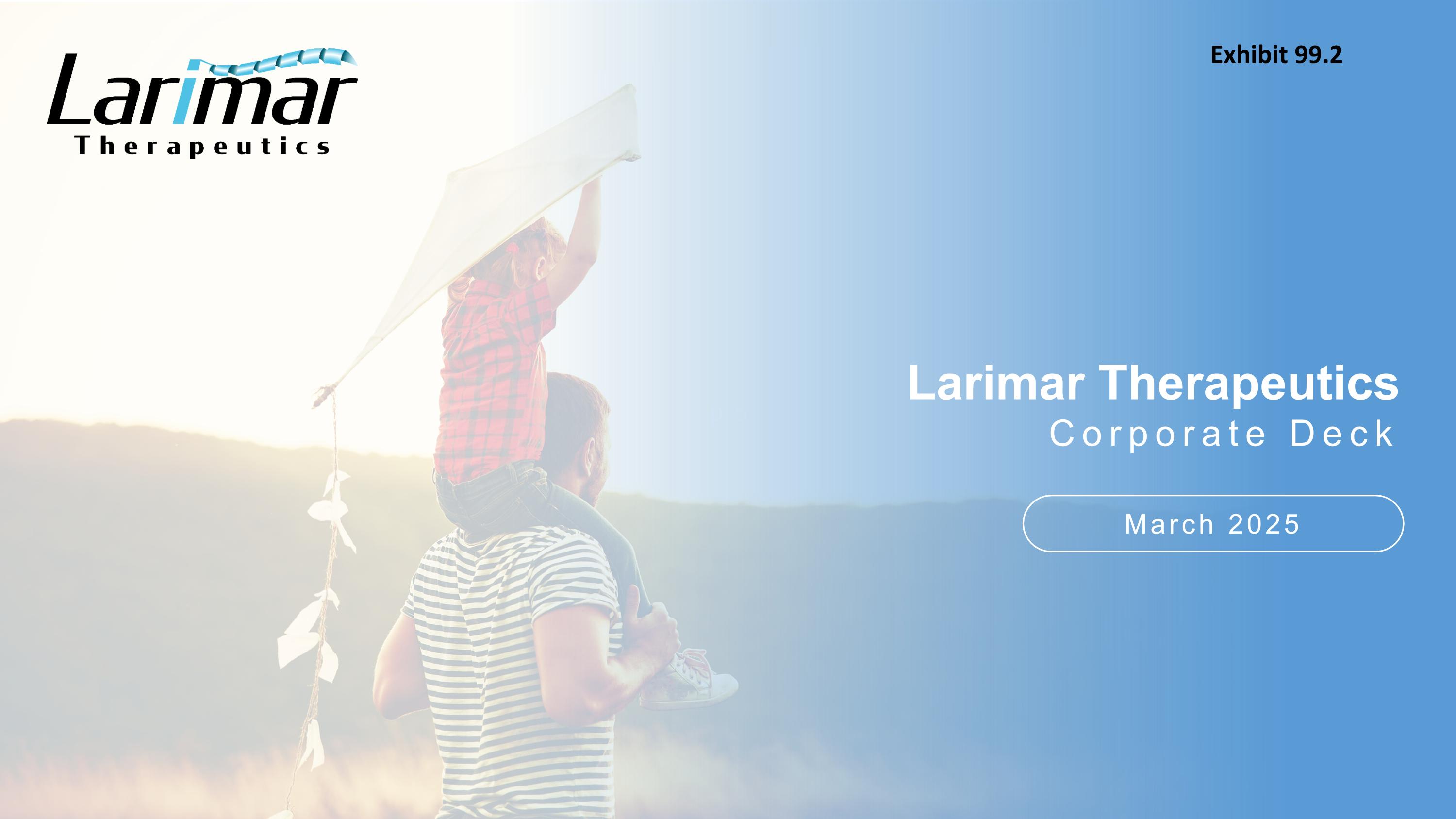
pro March 2025 Larimar Therapeutics Corporate Deck Exhibit 99.2

This presentation contains forward-looking statements that are based on the beliefs and assumptions of Larimar Therapeutics, Inc. ( “Company”) and on information currently available to management. All statements contained in this presentation other than statements of historical fact are forward-looking statements, including but not limited to Larimar’s ability to develop and commercialize nomlabofusp (CTI-1601) and any other planned product candidates, Larimar’s planned research and development efforts, including the timing of its nomlabofusp clinical trials and non-clinical investigations and overall development plan expectations with respect to the FDA START pilot program, interactions with FDA, expectations regarding potential for accelerated approval or accelerated access and time to market and other matters regarding Larimar’s business strategies, ability to raise capital, use of capital, results of operations and financial position, and plans and objectives for future operations. In some cases, you can identify forward-looking statements by the words “may,” “will,” “could,” “would,” “should,” “expect,” “intend,” “plan,” “anticipate,” “believe,” “estimate,” “predict,” “project,” “potential,” “continue,” “ongoing” or the negative of these terms or other comparable terminology, although not all forward-looking statements contain these words. These statements involve risks, uncertainties and other factors that may cause actual results, performance, or achievements to be materially different from the information expressed or implied by these forward-looking statements. These risks, uncertainties and other factors include, among others, the success, cost and timing of Larimar’s product development activities, nonclinical studies and clinical trials, including nomlabofusp clinical milestones and continued interactions with the FDA; that preliminary clinical trial results may differ from final clinical trial results, that earlier non-clinical and clinical data and testing of nomlabofusp may not be predictive of the results or success of later non-clinical or clinical trials, and assessments; delays in patient recruitment, including as a result of changes in clinical protocols and adverse events; that the FDA may not ultimately agree with Larimar’s nomlabofusp development strategy; the potential impact of public health crises on Larimar’s future clinical trials, manufacturing, regulatory, nonclinical study timelines and operations, and general economic conditions; Larimar’s ability and the ability of third-party manufacturers Larimar engages, to optimize and scale nomlabofusp’s manufacturing process; Larimar’s ability to obtain regulatory approvals for nomlabofusp and future product candidates; Larimar’s ability to develop sales and marketing capabilities, whether alone or with potential future collaborators, and to successfully commercialize any approved product candidates; Larimar’s ability to raise the necessary capital to conduct its product development activities; and other risks described in the filings made by Larimar with the Securities and Exchange Commission (SEC), including but not limited to Larimar’s periodic reports, including the annual report on Form 10-K, quarterly reports on Form 10-Q and current reports on Form 8-K, filed with or furnished to the SEC and available at www.sec.gov. These forward-looking statements are based on a combination of facts and factors currently known by Larimar and its projections of the future, about which it cannot be certain. As a result, the forward-looking statements may not prove to be accurate. The forward-looking statements in this presentation represent Larimar’s management’s views only as of the date hereof. Larimar undertakes no obligation to update any forward-looking statements for any reason, except as required by law. Forward-Looking Statements
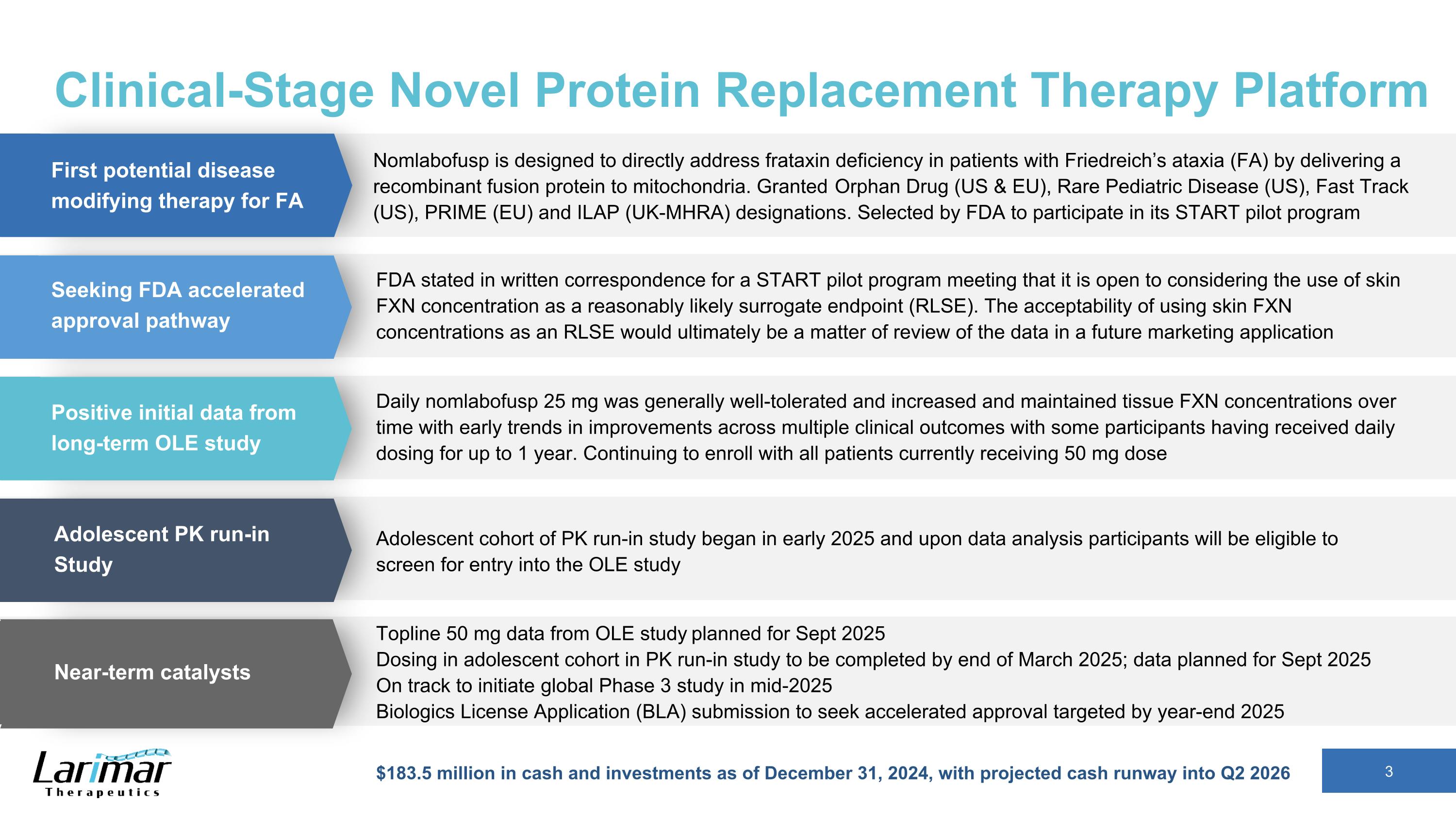
Clinical-Stage Novel Protein Replacement Therapy Platform Nomlabofusp is designed to directly address frataxin deficiency in patients with Friedreich’s ataxia (FA) by delivering a recombinant fusion protein to mitochondria. Granted Orphan Drug (US & EU), Rare Pediatric Disease (US), Fast Track (US), PRIME (EU) and ILAP (UK-MHRA) designations. Selected by FDA to participate in its START pilot program FDA stated in written correspondence for a START pilot program meeting that it is open to considering the use of skin FXN concentration as a reasonably likely surrogate endpoint (RLSE). The acceptability of using skin FXN concentrations as an RLSE would ultimately be a matter of review of the data in a future marketing application Daily nomlabofusp 25 mg was generally well-tolerated and increased and maintained tissue FXN concentrations over time with early trends in improvements across multiple clinical outcomes with some participants having received daily dosing for up to 1 year. Continuing to enroll with all patients currently receiving 50 mg dose Adolescent cohort of PK run-in study began in early 2025 and upon data analysis participants will be eligible to screen for entry into the OLE study Topline 50 mg data from OLE study planned for Sept 2025 Dosing in adolescent cohort in PK run-in study to be completed by end of March 2025; data planned for Sept 2025 On track to initiate global Phase 3 study in mid-2025 Biologics License Application (BLA) submission to seek accelerated approval targeted by year-end 2025 First potential disease modifying therapy for FA Seeking FDA accelerated approval pathway Positive initial data from long-term OLE study Adolescent PK run-in Study Near-term catalysts $183.5 million in cash and investments as of December 31, 2024, with projected cash runway into Q2 2026

Potential for Accelerated Approval Pathway Based on Skin FXN Concentrations as a Surrogate Endpoint FDA is open to considering the use of FXN concentration as a reasonably likely surrogate endpoint (RLSE) Skin FXN concentrations recommended by FDA as a RLSE to support evidence of effectiveness for accelerated approval BLA submission to seek accelerated approval targeted by year-end 2025 FDA noted submitted data appear sufficient to support relationship between increased skin FXN concentrations and relevant tissues such as heart, dorsal root ganglia and skeletal muscle FDA acknowledged nonclinical studies were done at relevant doses

Next Steps Potential Path to Bring Nomlabofusp to Patients Worldwide Completed dosing of 25 mg dose with positive initial data Continuing to enroll with all subjects on 50 mg dose Plan to introduce the lyophilized dosage form (formulation intended for commercialization) into clinical studies in mid-2025 Long-term 50 mg data expected Sept 2025 Dosing of adolescents (12-17 yrs of age) at weight-based dose expected to match PK of adult 50 mg dose, expected to be completed by end of March Participants eligible to transition into OLE after assessment of safety and PK data Data expected Sept 2025 OLE Study Adolescent PK Run-In Study Received feedback from FDA and EMA on study protocol for global double-blind placebo-controlled study Potential sites in the U.S., E.U., U.K., Canada, and Australia Plan to include children (2-17 yrs of age) Plan to initiate mid-2025 Global Phase 3 Study Continuing discussions with FDA to determine adequacy of the safety data set to support the BLA submission BLA submission to seek accelerated approval targeted by year-end 2025
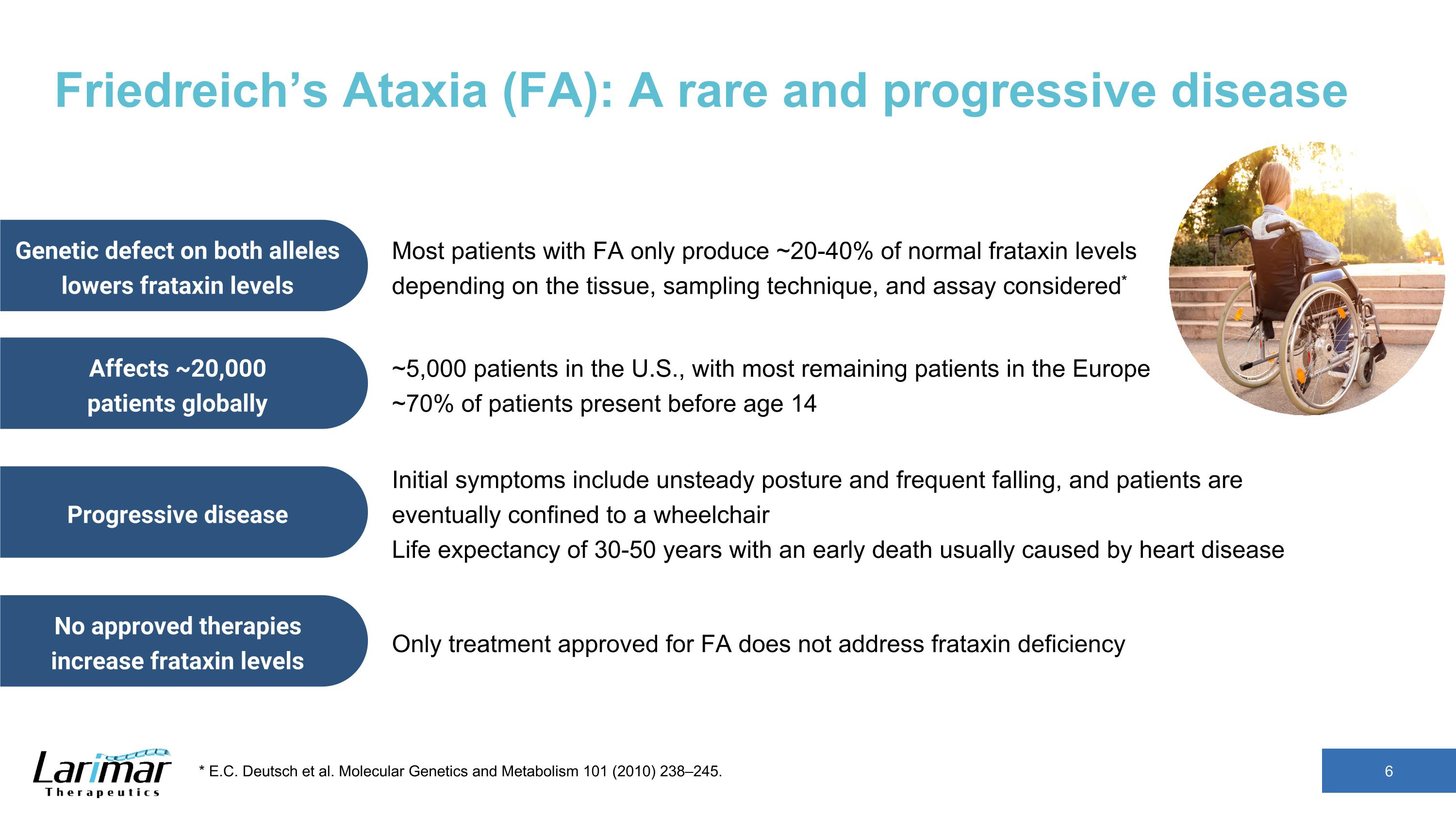
Friedreich’s Ataxia (FA): A rare and progressive disease 6 * E.C. Deutsch et al. Molecular Genetics and Metabolism 101 (2010) 238–245. Most patients with FA only produce ~20-40% of normal frataxin levels depending on the tissue, sampling technique, and assay considered* Genetic defect on both alleles lowers frataxin levels Progressive disease Initial symptoms include unsteady posture and frequent falling, and patients are eventually confined to a wheelchairLife expectancy of 30-50 years with an early death usually caused by heart disease Affects ~20,000 patients globally ~5,000 patients in the U.S., with most remaining patients in the Europe~70% of patients present before age 14 No approved therapies increase frataxin levels Only treatment approved for FA does not address frataxin deficiency
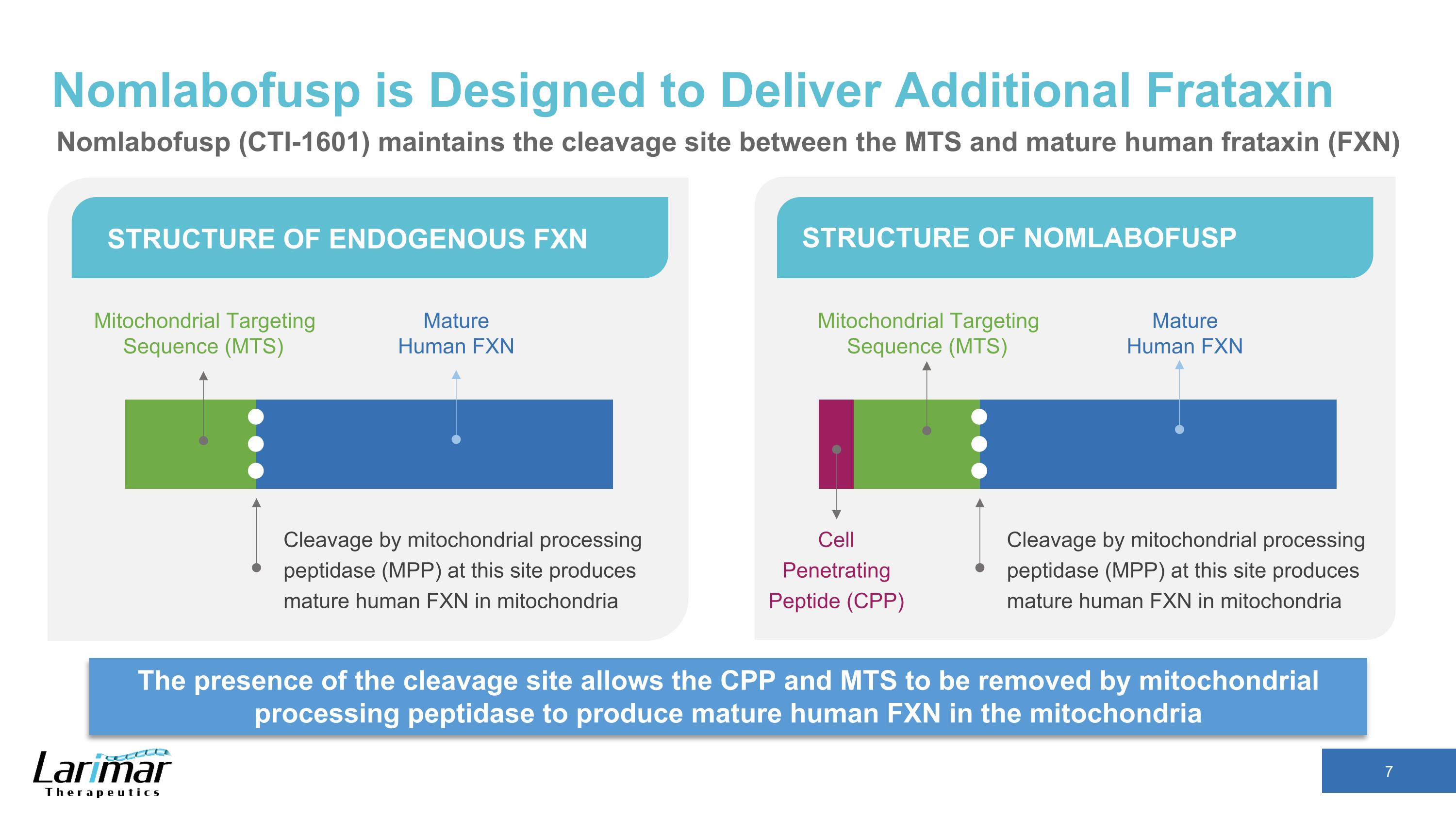
Nomlabofusp is Designed to Deliver Additional Frataxin The presence of the cleavage site allows the CPP and MTS to be removed by mitochondrial processing peptidase to produce mature human FXN in the mitochondria STRUCTURE OF ENDOGENOUS FXN STRUCTURE OF NOMLABOFUSP Cleavage by mitochondrial processing peptidase (MPP) at this site produces mature human FXN in mitochondria Mitochondrial Targeting Sequence (MTS) Mature Human FXN Cleavage by mitochondrial processing peptidase (MPP) at this site produces mature human FXN in mitochondria Mature Human FXN Cell Penetrating Peptide (CPP) Mitochondrial Targeting Sequence (MTS) Nomlabofusp (CTI-1601) maintains the cleavage site between the MTS and mature human frataxin (FXN)

FXN Levels Clearly Predict Disease Progression in FA Lower FXN levels are associated with earlier onset of disease, faster rate of disease progression, and shorter time to loss of ambulation Adapted from H.L.Plasterer et al. PLoS ONE 2013 8(5):e63958 Age of Onset (Years) Median Time to Loss of Ambulation (Years) < 15 11.5 15 to 24 18.3 > 24 23.5 Median Age of Onset and Rate of Disease Progression in Relation to FXN Levels *FXN levels measured in peripheral blood mononuclear cells (PBMCs). FXN levels as measured by % of normal demonstrated to be equivalent in PBMCs, buccal cells, and whole blood. **FARS: Friedreich’s ataxia rating score, measures disease progression with a higher score indicating a greater level of disability. FXN Level* (% of Normal Level) Age of Onset (Years) FARS** (Change/Year) 11.2 7 2.9 22.0 11 2.1 31.0 16 2.0 48.7 19 1.6 Adapted from C. Rummey et al. EClinicalMedicine. 2020 18:100213 Median Age of Onset Predicts Time to Loss of Ambulation
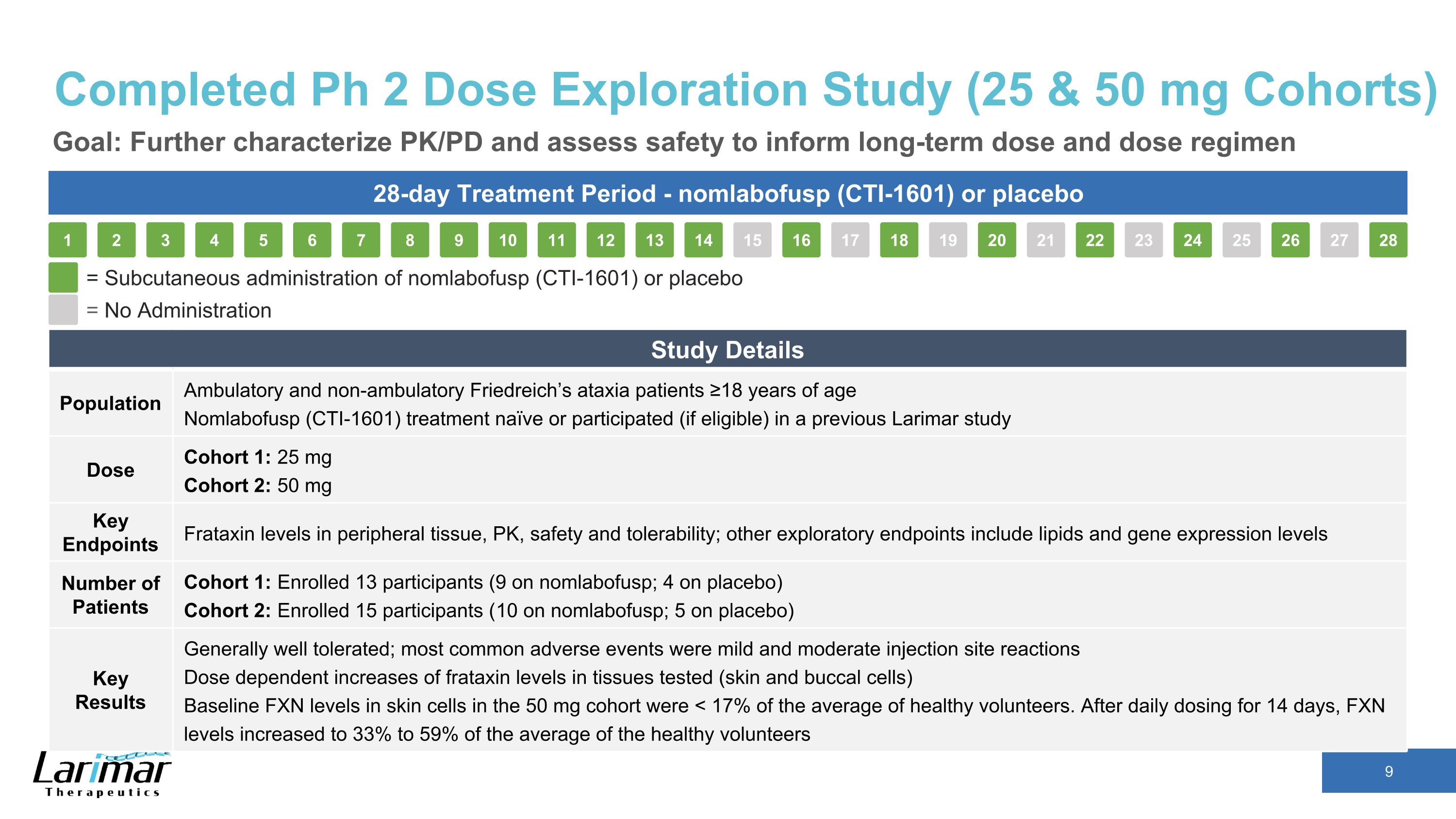
Completed Ph 2 Dose Exploration Study (25 & 50 mg Cohorts) Goal: Further characterize PK/PD and assess safety to inform long-term dose and dose regimen 28-day Treatment Period - nomlabofusp (CTI-1601) or placebo 16 17 18 19 15 20 21 22 23 24 25 26 27 28 2 3 4 5 1 6 7 8 9 10 11 12 13 14 = Subcutaneous administration of nomlabofusp (CTI-1601) or placebo = No Administration Study Details Population Ambulatory and non-ambulatory Friedreich’s ataxia patients ≥18 years of age Nomlabofusp (CTI-1601) treatment naïve or participated (if eligible) in a previous Larimar study Dose Cohort 1: 25 mg Cohort 2: 50 mg Key Endpoints Frataxin levels in peripheral tissue, PK, safety and tolerability; other exploratory endpoints include lipids and gene expression levels Number of Patients Cohort 1: Enrolled 13 participants (9 on nomlabofusp; 4 on placebo) Cohort 2: Enrolled 15 participants (10 on nomlabofusp; 5 on placebo) Key Results Generally well tolerated; most common adverse events were mild and moderate injection site reactions Dose dependent increases of frataxin levels in tissues tested (skin and buccal cells) Baseline FXN levels in skin cells in the 50 mg cohort were < 17% of the average of healthy volunteers. After daily dosing for 14 days, FXN levels increased to 33% to 59% of the average of the healthy volunteers
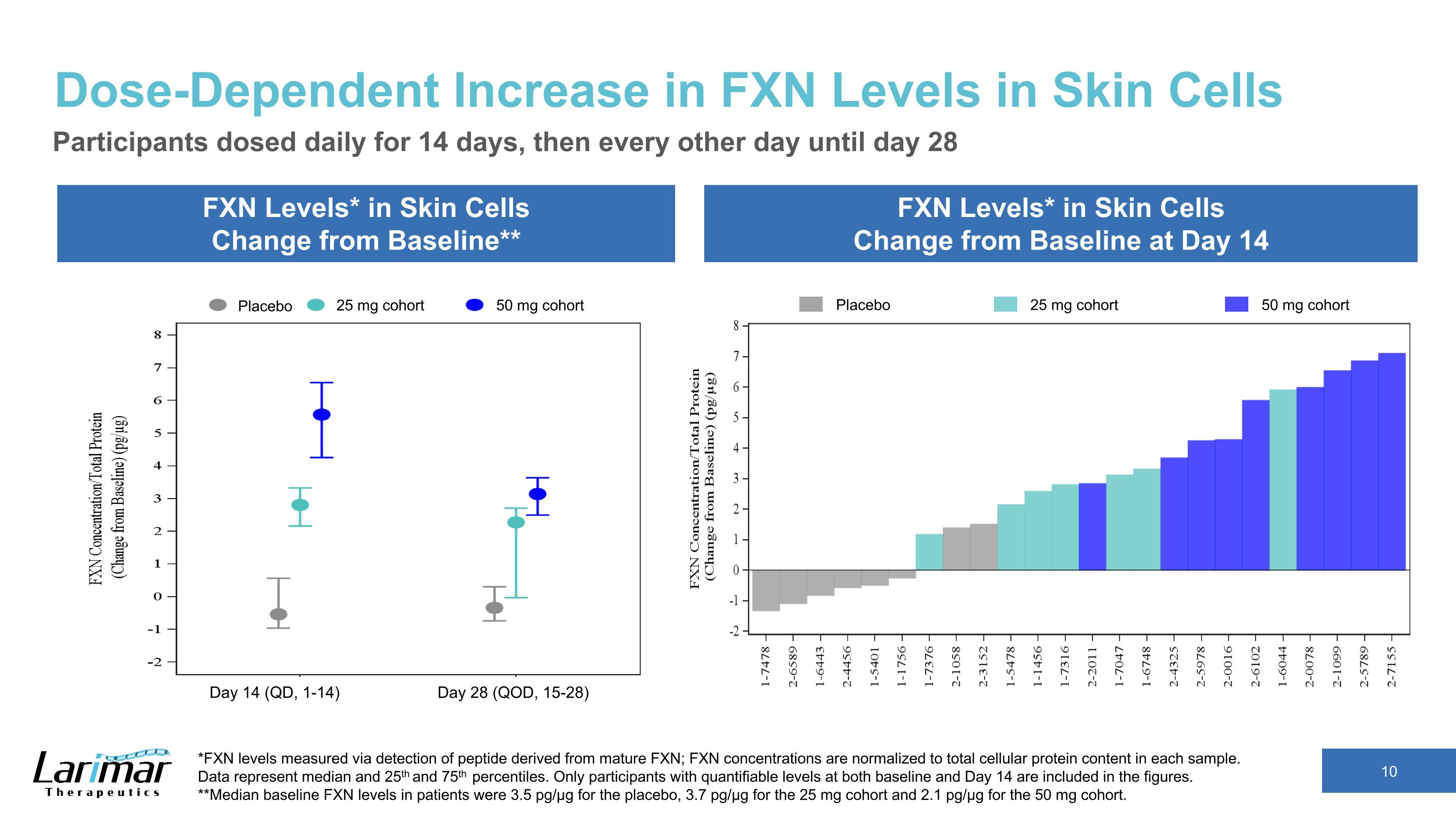
Dose-Dependent Increase in FXN Levels in Skin Cells FXN Levels* in Skin Cells Change from Baseline** FXN Levels* in Skin Cells Change from Baseline at Day 14 Participants dosed daily for 14 days, then every other day until day 28 *FXN levels measured via detection of peptide derived from mature FXN; FXN concentrations are normalized to total cellular protein content in each sample.Data represent median and 25th and 75th percentiles. Only participants with quantifiable levels at both baseline and Day 14 are included in the figures. **Median baseline FXN levels in patients were 3.5 pg/µg for the placebo, 3.7 pg/µg for the 25 mg cohort and 2.1 pg/µg for the 50 mg cohort. Placebo 25 mg cohort 50 mg cohort Placebo 25 mg cohort 50 mg cohort Day 14 (QD, 1-14) Day 28 (QOD, 15-28)

Skin Cell FXN Levels Achieve Higher % of Healthy Volunteers* Following 14 days of Daily Nomlabofusp Only participants with quantifiable levels at baseline and day 14 are included in the figures. *% of healthy volunteer FXN level is calculated by dividing each participant's FXN level by the average FXN level (16.34 pg/µg) from the noninterventional healthy volunteer study (N=60). 25 mg of Nomlabofusp 50 mg of Nomlabofusp Baseline FXN levels as a % of average FXN level in healthy volunteers FXN levels increased from baseline and reached > 50% of average FXN level in healthy volunteers FXN levels increased from baseline and reached 25% to < 50% of average FXN level in healthy volunteers % of healthy volunteer FXN level % of healthy volunteer FXN level

Increase Towards Normal Gene Expression in Adults with FA* Observed After Nomlabofusp Treatment Select Baseline Gene Expression Patients with FA* vs. Healthy Volunteers (HV)** Post-treatment Changes in Gene Expression From Baseline Data presented at the International Congress for Ataxia Research, November 2024 *Samples from Phase 2 dose exploration study evaluating nomlabofusp 25 mg (Cohort 1) and 50 mg (Cohort 2) or placebo via subcutaneous injection daily for 14 days followed by alternate day administration for 14 days. Buccal samples were collected before, during, and after treatment for gene expression profiling **Data from Larimar’s non-interventional healthy volunteer study No different than HV

Interest from FDA in Exploring the Correlation Between Lipids and FXN Concentrations *Samples from Phase 2 dose exploration study evaluating nomlabofusp 25 mg (Cohort 1) and 50 mg (Cohort 2) or placebo via subcutaneous injection daily for 14 days followed by alternate day administration for 14 days. Plasma samples were collected before, during, and after treatment for lipid profiling. Healthy volunteer (HV) data is from Larimar’s non-interventional HV study Select Baseline Triglyceride (TG) Profiles Post-Treatment TG Profiles (D28) Data presented at the International Congress for Ataxia Research, November 2024 Decreases in elevated lipids in adults with FA* observed after nomlabofusp treatment

Nomlabofusp Long-term Open Label Extension Study

Open-label Extension: 25 mg Completed, Dosing at 50 mg Continues Key Eligibility Criteria Previous participation in Phase 1 or Phase 2 trials Key Study Objectives Safety and tolerability Long-term PK Tissue FXN concentrations Clinical efficacy measures compared to FACOMS* database once enrollment is complete *FACOMS: Friedreich’s Ataxia Clinical Outcome Measures Study. **Estimated screening period may be extended for those study participants who have not been on a stable regimen of omaveloxolone for at least six months. Screening Period ≤ 42 days** Treatment Period Planned for ≥ 1 year All 7 sites activated and enrolling Following assessment of safety and PK data of cohorts in the PK run-in study, adolescents (12-17 yrs of age) and children (2-11 yrs of age) will be eligible to screen for the OLE Potential extensions Daily subcutaneous injections self-administered or by a caregiver 25 mg nomlabofusp 50 mg nomlabofusp Long-term data from 50 mg dose expected September 2025
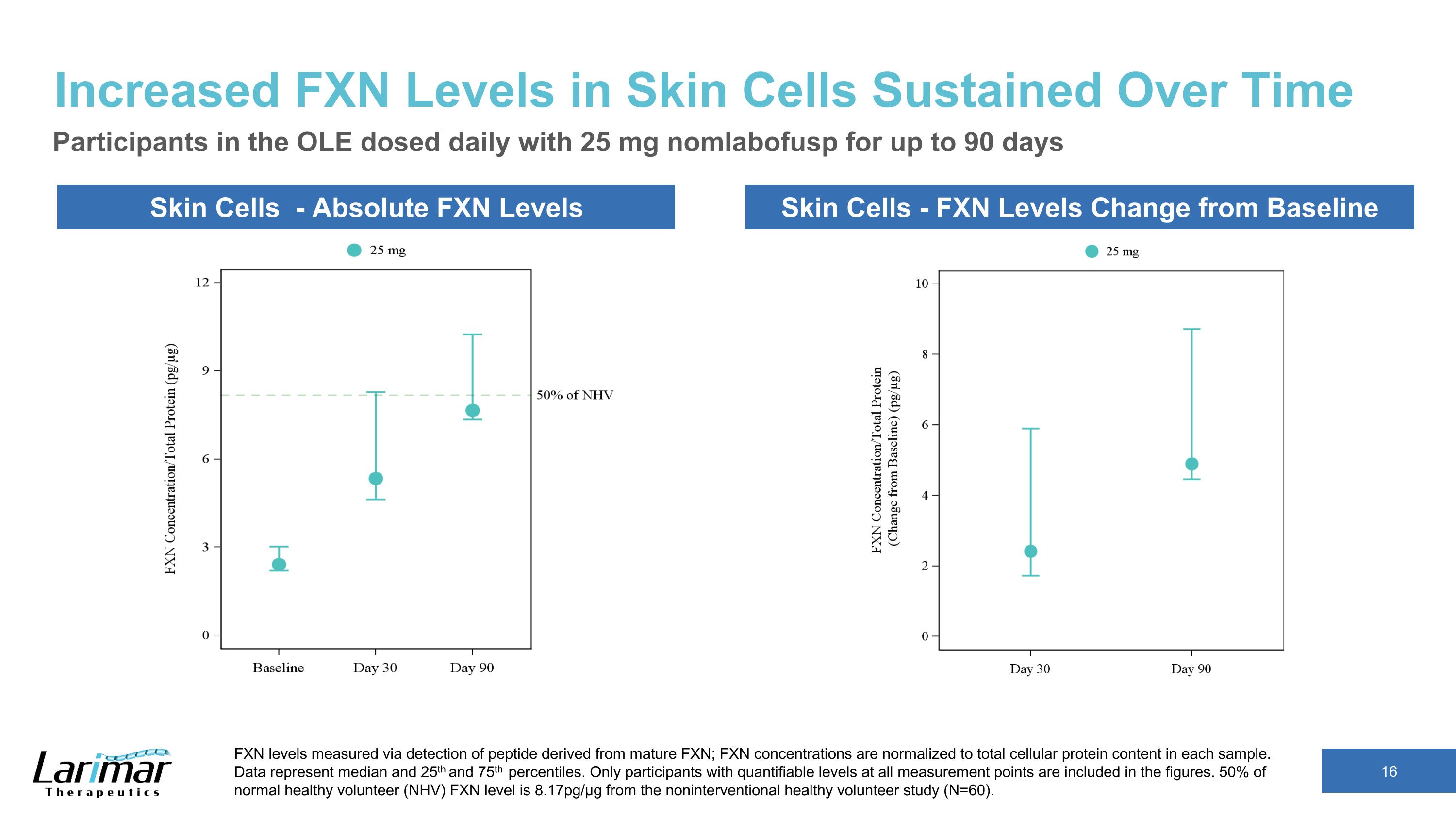
Increased FXN Levels in Skin Cells Sustained Over Time Skin Cells - Absolute FXN Levels Participants in the OLE dosed daily with 25 mg nomlabofusp for up to 90 days Skin Cells - FXN Levels Change from Baseline FXN levels measured via detection of peptide derived from mature FXN; FXN concentrations are normalized to total cellular protein content in each sample.Data represent median and 25th and 75th percentiles. Only participants with quantifiable levels at all measurement points are included in the figures. 50% of normal healthy volunteer (NHV) FXN level is 8.17pg/µg from the noninterventional healthy volunteer study (N=60).

Increased FXN Levels in Buccal Cells Sustained Over Time OLE participants dosed daily with 25 mg nomlabofusp for up to 90 days reached steady state by 30 days Buccal Cells - Absolute FXN Levels Buccal Cells - FXN Levels Change from Baseline FXN levels measured via detection of peptide derived from mature FXN; FXN concentrations are normalized to total cellular protein content in each sample.Data represent median and 25th and 75th percentiles. Only participants with quantifiable levels at all measurement points are included in the figures. 50% of normal healthy volunteer (NHV) FXN level is 4.12 pg/µg from the noninterventional healthy volunteer study (N=60).

Tissue FXN Levels as a % of Healthy Volunteers are Higher at Day 90 Compared to Baseline in Subjects Treated with 25 mg Daily in the OLE 30% at Day 90 (18.68 % min, 53.18 % max) 15% at baseline (5.30% min, 26.67% max) Mean % of healthy volunteers 72% at Day 90 (43.86 % min, 160.61 % max) 16% at baseline (9.33% min, 24.48% max) Skin FXN Levels Mean % of healthy volunteers Only participants with quantifiable levels at each measurement point are included in the tables Mean % of healthy volunteers is the mean of all the participants FXN levels relative to the mean FXN levels in skin cells (16.34 pg/µg) and in buccal cells (8.24 pg/µg) from the noninterventional healthy volunteer study (N=60). Buccal FXN Levels

Open Label Extension Buccal FXN levels (pg/μg) Skin FXN levels (pg/μg) n Median Mean n Median Mean Baseline 11 1.13 1.19 8 2.41 2.60 Day 30 11 2.08 3.62 8 5.34 7.45 Change from Baseline 11 0.58 2.43 8 2.42 4.85 Day 60 9 2.46 2.41 Change from Baseline 9 0.53 1.13 Day 90 6 1.89 2.48 5 7.65 11.73 Change from Baseline 6 1.01 1.32 5 4.89 9.28 Observed Increases in Tissue FXN Levels in OLE Are Comparable to the Phase 2 Dose Exploration Study Absolute tissue FXN levels and increases from baseline after 25 mg nomlabofusp daily over time Skin samples not collected at Day 60 per study protocol Only participants with quantifiable levels at each measurement point are included in the tables Phase 2 Dose Exploration Buccal FXN levels (pg/μg) Skin FXN levels (pg/μg) n Median Mean n Median Mean Baseline 7 1.78 1.80 7 3.70 3.38 Day 14 7 2.24 2.22 7 5.53 6.4 Change from Baseline 7 0.56 0.42 7 2.81 3.02

Observed Trends Towards Improvement in Clinical Outcomes at Day 90 in OLE After Daily 25 mg Nomlabofusp Visit Statistic mFARS 93-Point Scale FARS-ADL 36-Point Scale Modified Fatigue Impact Scale 84-Point Scale 9 Hole Peg Test Dominant Hand Time (Seconds) N = 8 N = 8 N = 8 N = 8 Baseline Mean (SD) 55.81 (13.296) 18.13 (6.064) 27.1 (14.23) 130.91 (99.366) Median (IQR) 53.5 (47.5, 68.3) 17.0 (12.8, 23.8) 29.5 (18, 38) 89.5 (48.7, 227.8) (Min, Max) (35.0, 73.0) (11.0, 27.0) (2, 45) (38.0, 277.3) Day 90 Mean (SD) 55.13 (14.829) 15.88 (6.249) 18.5 (15.68) 113.11 (95.586) Median (IQR) 53.3 (43.8, 66.0) 14.8 (11.0, 21.3) 17.0 (5, 32) 67.15 (48.4, 176.7) (Min, Max) (35.3, 79.5) (8.0, 25.0) (0, 42) (33.50, 287.00) Change from Baseline at Day 90 Mean (SD) -0.69 (3.983) -2.25 (3.082) -8.6 (12.24) -17.79 (27.450) Median (IQR) -1.17 (-3.8, 1.2) -2.25 (-3.8, 0.3) -3.5 (-19, -3) -9.00 (-32.0, 1.7) (Min, Max) (-5.0, 7.0) (-8.0, 1.5) (-28, 9) (-73.5, 9.8) Timed 25-Foot Walk is not presented due to participants’ ambulatory status

Safety Data from OLE Update in Dec 2024 Nomlabofusp has Been Generally Well-Tolerated in OLE 14 participants with FA were included in the safety data Two participants withdrew for non-treatment related reasons Two participants had serious adverse events that resolved within 24 hours and withdrew from the study Events were reviewed by Data Monitoring Committee and submitted to FDA and study is continuing as planned Most common adverse event (AE) was injection site reactions (ISRs) which were mild, brief in duration and self limited No study discontinuations due to ISRs and all resolved All patients in the OLE study are receiving 50 mg daily Larimar’s Safety Monitoring Team determined anaphylaxis to be an adverse drug reaction likely associated with nomlabofusp To decrease the potential for allergic reactions, patients will be premedicated for the first month of dosing OLE Q1 2025 Updates

Near-Term Milestones Support BLA Submission by End 2025 Feedback on protocol received from FDA and EMA On track to initiate mid- 2025 Dosing of study participants to be completed by end of March Study participants are eligible to screen for the OLE after assessment of safety and PK data Data expected September 2025 Introduction of lyophilized dosage form (formulation intended for commercialization) planned mid-2025 Topline 50 mg data from ongoing study expected September 2025 Continuing discussions with FDA on adequacy of safety data set BLA seeking accelerated approval expected by year-end 2025 Open-Label Extension Study Adolescent PK Run-In Cohort BLA Submission GlobalPhase 3 Study Larimar Selected to Participate in FDA START Pilot Program

Clinical-Stage Novel Protein Replacement Therapy Platform Nomlabofusp is designed to directly address frataxin deficiency in patients with Friedreich’s ataxia (FA) by delivering a recombinant fusion protein to mitochondria. Granted Orphan Drug (US & EU), Rare Pediatric Disease (US), Fast Track (US), PRIME (EU) and ILAP (UK-MHRA) designations. Selected by FDA to participate in its START pilot program FDA stated in written correspondence for a START pilot program meeting that it is open to considering the use of skin FXN concentration as a reasonably likely surrogate endpoint (RLSE). The acceptability of using skin FXN concentrations as an RLSE would ultimately be a matter of review of the data in a future marketing application Daily nomlabofusp 25 mg was generally well-tolerated and increased and maintained tissue FXN concentrations over time with early trends in improvements across multiple clinical outcomes with some participants having received daily dosing for up to 1 year. Continuing to enroll with all patients currently receiving 50 mg dose Adolescent cohort of PK run-in study began in early 2025 and upon data analysis participants will be eligible to screen for entry into the OLE study Topline 50 mg data from OLE study planned for Sept 2025 Dosing in adolescent cohort in PK run-in study to be completed by end of March 2025; data planned for Sept 2025 On track to initiate global Phase 3 study in mid-2025 Biologics License Application (BLA) submission to seek accelerated approval targeted by year-end 2025 First potential disease modifying therapy for FA Seeking FDA accelerated approval pathway Positive initial data from long-term OLE study Adolescent PK run-in Study Near-term catalysts $183.5 million in cash and investments as of December 31, 2024, with projected cash runway into Q2 2026

Appendix Larimar Therapeutics

2015 2020 2030 2035 2040 2045 2050 2055 2010 2025 Nomlabofusp Composition of Matter and Methods of Treatment US 11,459,363 and US 12,180,253 (Exclusive license from Indiana University) US continuation and foreign applications pending Expiration July 2040 Composition of Matter Patent Larimar Technology is Supported by a Strong IP Portfolio Granted nomlabofusp (CTI-1601) composition of matter patent extends into 2040 Additional nomlabofusp IP protection US and foreign pending applications and patents cover key biomarkers, analytical tools and methods of treatment for additional disease indications for nomlabofusp Nomlabofusp should be eligible for 12 years of market exclusivity upon approval in the US (independent of patents) and at least 10 years of market exclusivity upon approval in EU (independent of patents) Pending Granted Platform Applications Formulation and Methods of Quantifying Nomlabofusp Platform Technology: Molecules for Protein Delivery US 11,891,420 and US 12,091,437 US continuations and foreign applications pending Pharmaceutical Compositions Comprising Nomlabofusp US 2022-0193190 US and foreign applications pending Methods of Quantifying Nomlabofusp US 2022-0276258 US and foreign applications pending Est. Expiration December 2041 Est. Expiration July 2040 Expiration August 2041 (with PTA)

Nomlabofusp is a Competitively Differentiated Treatment Approach* *Competitive landscape focuses on clinical-stage, industry-sponsored programs from public companies Acquisition supports the robust market potential for FA treatments Nomlabofusp is a potential first-and-only protein replacement therapy designed to address the underlying cause of FA $7.3B Approach Product Company Mechanism of Action Clinical Status Protein replacement Nomlabofusp (CTI-1601) Larimar Frataxin Protein Replacement Phase II Mitochondrial Oxidative Stress Modifier Omaveloxolone (SKYCLARYS™) Biogen Nrf2 Activator Approved (US and EU) Vatiquinone PTC Therapeutics 15-Lipoxygenase Inhibitor Phase III Gene Expression Regulator DT-216P2 (new formulation) Design Therapeutics GeneTAC Pre-clinical Gene Therapy LX2006 Lexeo Therapeutics Frataxin Gene Replacement Phase I/II
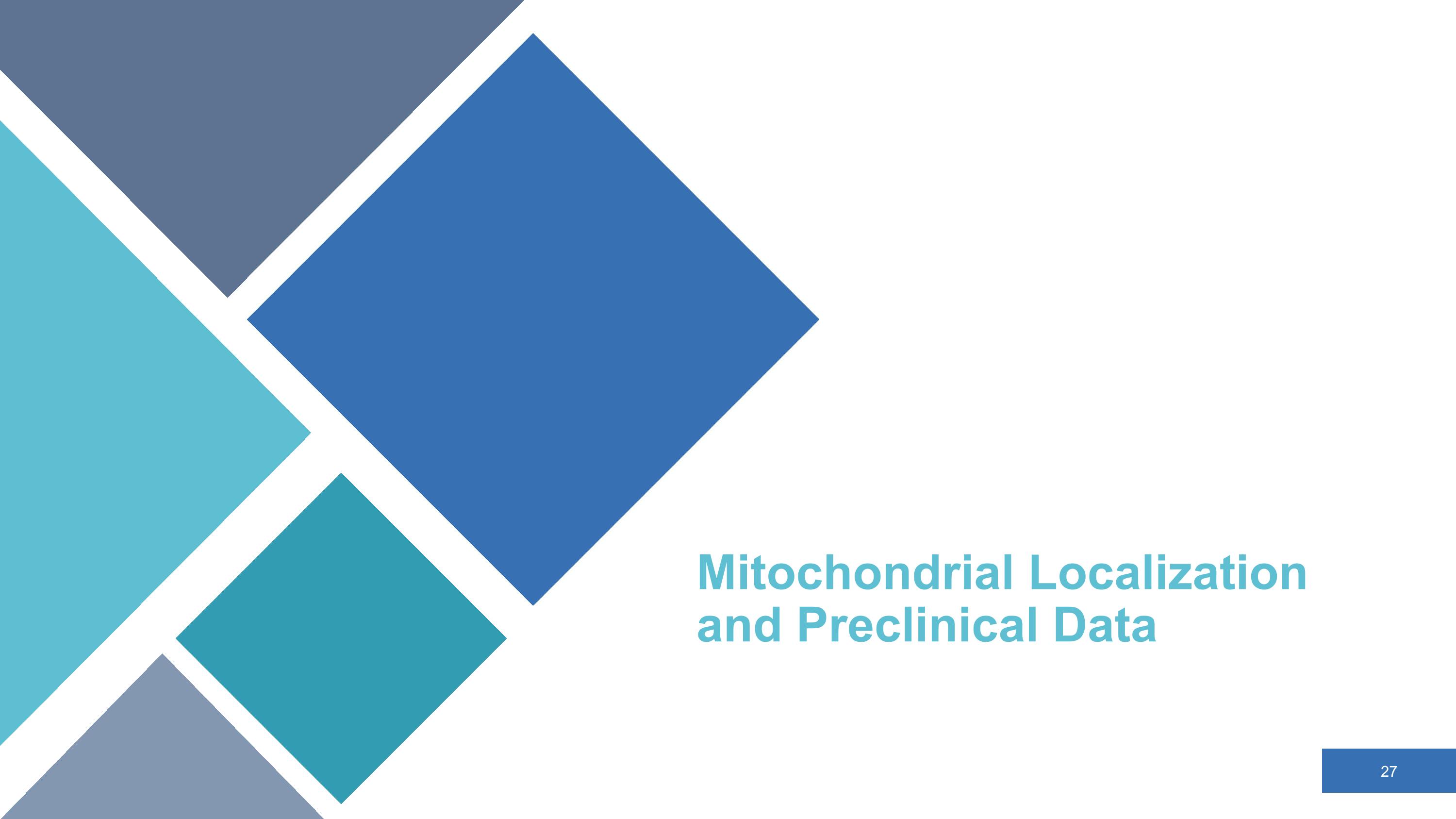
Mitochondrial Localization and Preclinical Data

Nomlabofusp Transduction of Cells In Vitro Leads to hFXN Located in Mitochondria FXN DAPI TOMM20 DAPI FXN TOMM20 DAPI FXN co-localizes with TOMM20 FXN staining TOMM20 (mitochondria) staining Rat cardiomyocytes (H9C2) were transduced with nomlabofusp Cells were fixed and analyzed by immunofluorescence microscopy to detect the presence of human frataxin (hFXN) and TOMM20 ( a mitochondrial outer membrane protein) Nuclei were stained with DAPI
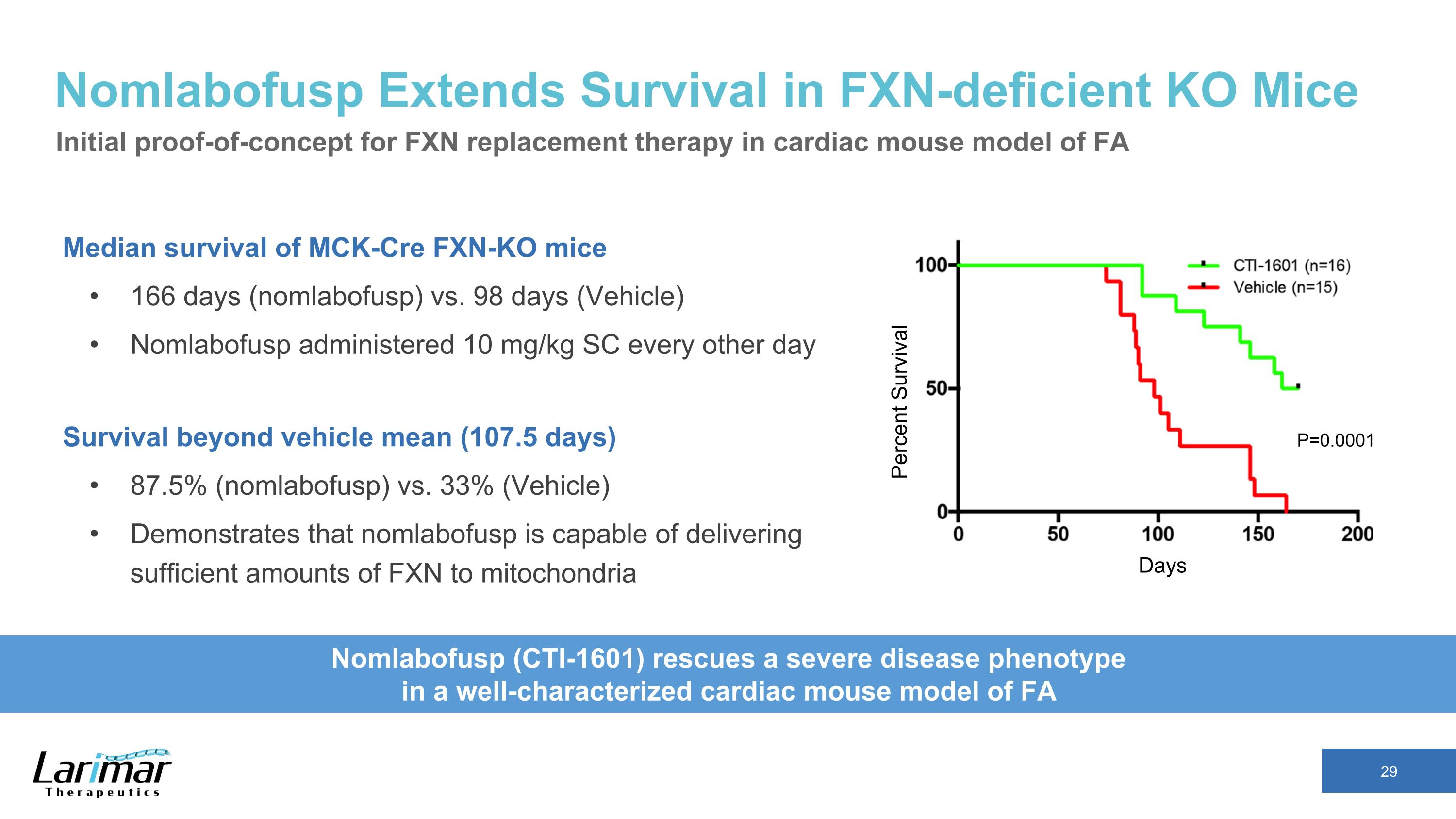
Nomlabofusp Extends Survival in FXN-deficient KO Mice Median survival of MCK-Cre FXN-KO mice 166 days (nomlabofusp) vs. 98 days (Vehicle) Nomlabofusp administered 10 mg/kg SC every other day Survival beyond vehicle mean (107.5 days) 87.5% (nomlabofusp) vs. 33% (Vehicle) Demonstrates that nomlabofusp is capable of delivering sufficient amounts of FXN to mitochondria Days Percent Survival Nomlabofusp (CTI-1601) rescues a severe disease phenotype in a well-characterized cardiac mouse model of FA P=0.0001 Initial proof-of-concept for FXN replacement therapy in cardiac mouse model of FA
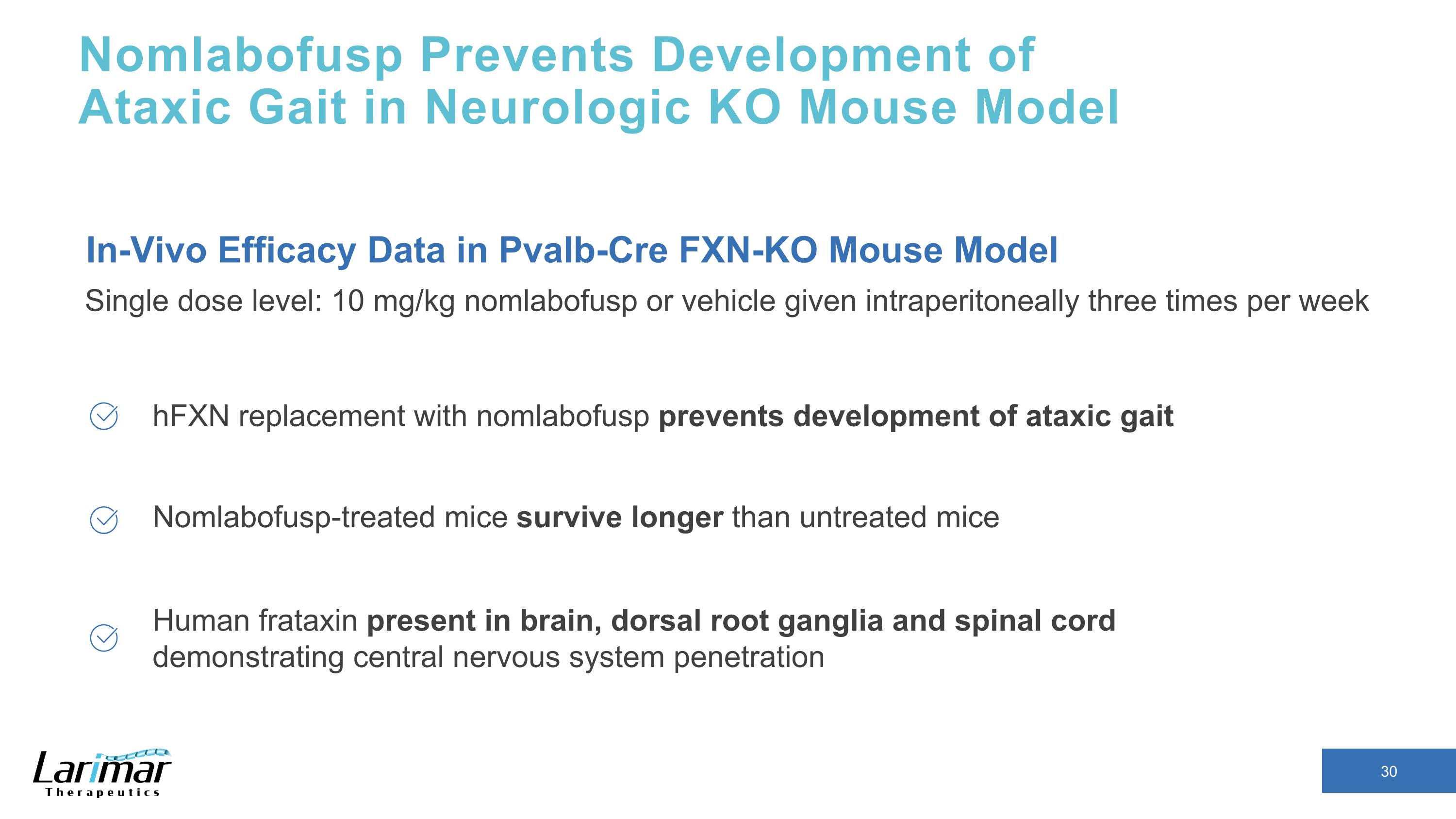
Nomlabofusp Prevents Development of Ataxic Gait in Neurologic KO Mouse Model hFXN replacement with nomlabofusp prevents development of ataxic gait Nomlabofusp-treated mice survive longer than untreated mice Human frataxin present in brain, dorsal root ganglia and spinal cord demonstrating central nervous system penetration In-Vivo Efficacy Data in Pvalb-Cre FXN-KO Mouse Model Single dose level: 10 mg/kg nomlabofusp or vehicle given intraperitoneally three times per week

Nomlabofusp Delivers hFXN to Mitochondria and Restores SDH Activity in KO Mice Mitochondria hFXN concentration increases dose-dependently Given subcutaneously, nomlabofusp functionally replaces hFXN in mitochondria of KO mice MPK = mg/kg MPK = mg/kg Mitochondrial FXN (Heart) SDH Activity (Muscle) Succinate dehydrogenase (SDH) activity, which is indicative of mitochondrial function, increases in a dose-dependent manner after administration of nomlabofusp; activity plateaus at 30 mg/kg and is equivalent to activity in wild type Study Design – Cardiac and skeletal muscle FXN knockout mice (MCK-CRE) were treated at varying SQ doses of nomlabofusp every other day for two weeks at Jackson Laboratories (Bar Harbor, ME). After dosing, animals were sacrificed, and heart and skeletal muscle were evaluated for hFXN concentration in mitochondrial extracts and SDH activity was assessed.

Nomlabofusp Prevents Left Ventricle Dilation in KO Mice Left ventricular (LV) volume increases in systole in untreated mice by 8 weeks (after 4 weeks of dosing with vehicle), but remains similar to wildtype when treated with nomlabofusp (10 mg/kg every other day) Diameter (mm) Age in Weeks Age in Weeks Volume (μL) KO: CTI-1601 Wild-type: Vehicle KO: Vehicle Left Ventricle Internal Diameter (Systole) Left Ventricle Volume (Systole) Study Design – Cardiac and skeletal muscle FXN knockout mice (MCK-CRE) were treated at 10 mg/kg every other day at Jackson Laboratories (Bar Harbor, ME). Echocardiograms were performed pre-dose and post dose. Nomlabofusp-treated mice have similar LV volume as wild type; echocardiogram shows significant differences between vehicle and nomlabofusp treated (10 mg/kg every other day) KO mice

Nomlabofusp Preserves Left Ventricle Function in KO Mice Percent Change Age in Weeks Left Ventricle Ejection Function Left Ventricle Fractional Shortening Percent Change Age in Weeks KO: CTI-1601 Wild-type: Vehicle KO: Vehicle Study Design – Cardiac and skeletal muscle FXN knockout mice (MCK-CRE) were treated at 10 mg/kg every other day at Jackson Laboratories (Bar Harbor, ME). Echocardiograms were performed pre-dose and post dose. Left ventricular (LV) function drops significantly in vehicle treated mice by Week 8 Nomlabofusp-treated (10 mg/kg every other day) mice have similar LV function as wildtype; echocardiogram shows significant differences between vehicle and nomlabofusp treated KO mice
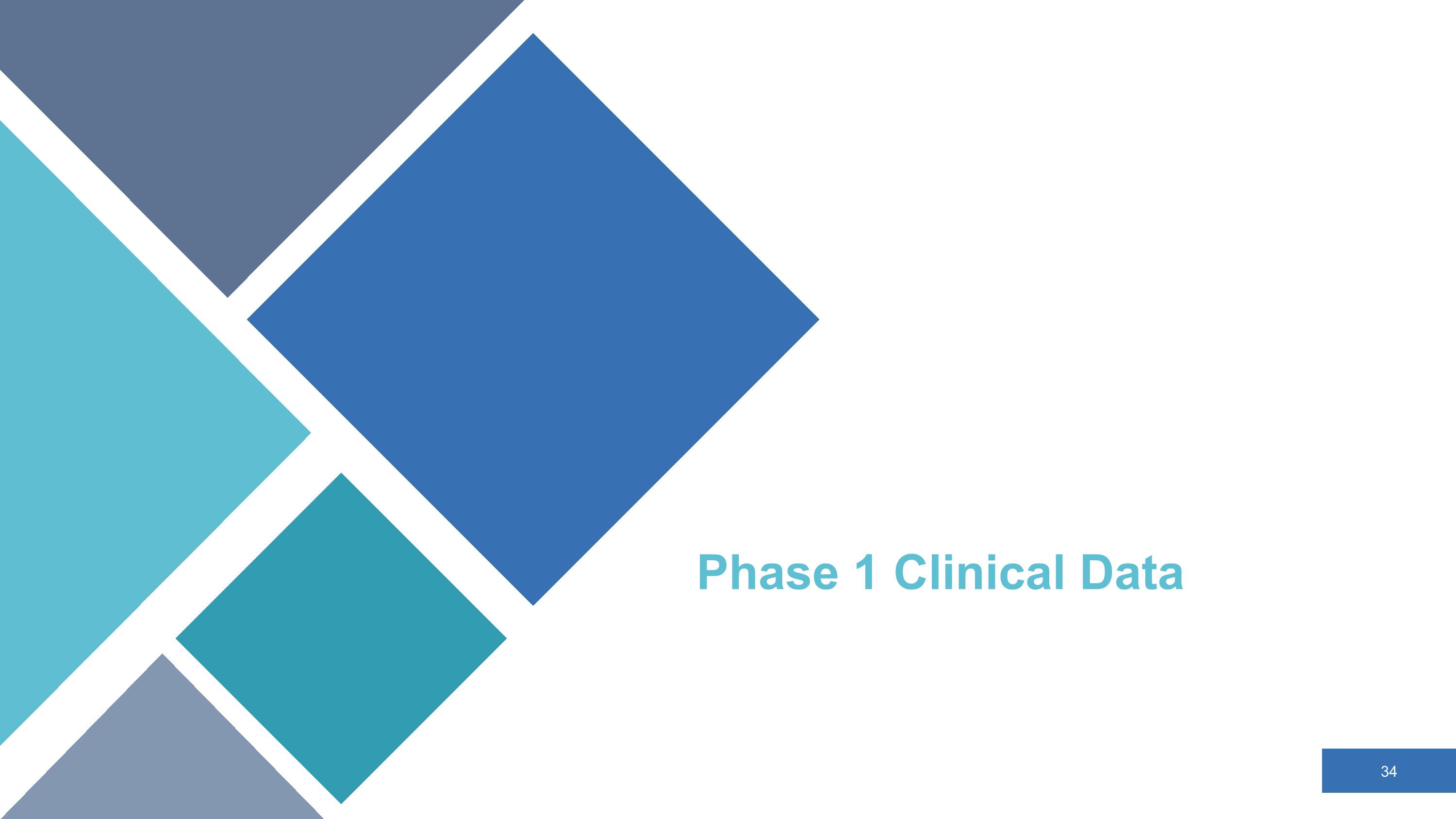
Phase 1 Clinical Data

CTI-1601: Phase 1 Clinical Program in Patients with FA Phase 1 Development Plan Two double-blind, placebo-controlled dosing trials in patients with FA Patient dosing began December 2019 Safety Review Committee assessed all blinded data between each cohort to ensure patient safety Number of subjects: 28 Dose levels: 25 mg, 50 mg, 75 mg and 100 mg (subcutaneous administration) Treatment Duration: 1 day 1º Endpoint: Safety and tolerability 2º Endpoints: PK; PD; FXN levels; multiple exploratory Status: Complete Single Ascending Dose (SAD) Number of Subjects: 27 Dose Range: 25 mg, 50 mg, 100 mg (subcutaneous administration) Treatment Regimen: Multiple increasing doses administered subcutaneously over 13 days 1º Endpoint: Safety and tolerability 2º Endpoints: PK; PD; FXN levels (buccal cells, platelets, optional skin biopsies); multiple exploratory Status: Complete Multiple Ascending Dose (MAD) Eligible patients from SAD trial could enroll in MAD trial Program consisted of double-blind, placebo controlled single- and multiple-ascending dose trials

Completed Phase 1 Multiple Ascending Dose Study Treatment Schedules for Each Cohort- nomlabofusp (CTI-1601) or placebo 13-day Treatment Period Cohort 2 (50 mg; n = 9) 2 3 4 5 1 6 7 8 9 10 11 12 13 14 = Administration of nomlabofusp or placebo = No Administration 13-day Treatment Period Cohort 1 (25 mg; n = 8) 2 3 4 5 1 6 7 8 9 10 11 12 13 14 = Administration of nomlabofusp or placebo = No Administration 13-day Treatment Period Cohort 3 (100 mg n = 10) 2 3 4 5 1 6 7 8 9 10 11 12 13 14 = Administration of nomlabofusp or placebo = No Administration FXN Level Sampling Days Presented for Each Cohort Cohort 1 Sampling Days Buccal Cells Baseline, Day 4, Day 13 Skin Baseline, Day 13 Platelets Baseline, Day 4, Day 13 Cohort 2 Sampling Days Buccal Cells Baseline, Day 7, Day 13 Skin Baseline, Day 13 Platelets Baseline, Day 7, Day 13 Cohort 3 Sampling Days Buccal Cells Baseline, Day 7, Day 13 Skin Baseline, Day 13 Platelets Baseline, Day 7, Day 13

Dose Dependent Increases in FXN Levels Observed in Skin and Buccal Cells in Phase 1 *FXN levels measured via detection of peptide derived from mature FXN; FXN concentrations are normalized to total cellular protein content in each sample; Data represent median and 25th and 75th percentiles; FXN levels from Day 4, & Day 13 measurements are shown for data derived from the 25 mg cohort; FXN levels from Day 7 & Day 13 measurements are shown for data derived from the 50 & 100 mg cohorts; FXN* Change from Baseline By Dose Group (Skin Cells) FXN* Change from Baseline By Dose Group (Buccal Cells) Placebo: Participants randomized to placebo in each cohort 25 mg: Dosed daily for 4 days, every third day thereafter 50 mg: Dosed daily for 7 days, every other day thereafter 100 mg: Dosed daily for 13 days

MAD Trial Patient Demographics Parameter Statistic All placebo (n=7) 25 mg CTI-1601 (n=6) 50 mg CTI-1601 (n=7) 100 mg CTI-1601 (n=7) All CTI-1601 (n=20) Overall (n=27) Sex Male n (%) 5 (71.4) 3 ( 50.0) 4 ( 57.1) 3 ( 42.9) 10 ( 50.0) 15 (55.6) Female n (%) 2 (28.6) 3 ( 50.0) 3 ( 42.9) 4 ( 57.1) 10 ( 50.0) 12 (44.4) Age (years) Mean 25.7 39.7 34.7 28.0 33.9 31.7 SD 6.37 16.59 9.03 8.96 12.13 11.40 Median 23 37 36 24 34 28 Min, Max 20,36 21,65 19,47 20,44 19,65 19,65 Race White n (%) 6 ( 85.7) 6 (100.0) 6 ( 85.7) 6 ( 85.7) 18 ( 90.0) 24 (88.9) Asian n (%) 0 0 1 ( 14.3) 1 ( 14.3) 2 ( 10.0) 2 ( 7.4) American Indian n (%) 1 ( 14.3) 0 0 0 0 1 (3.7) Ethnicity Hispanic/Latino n (%) 2 (28.6) 0 0 0 0 2 (7.4) Not Hispanic/Latino n (%) 5 (71.4) 6 (100.0) 7 (100.0) 7 (100.0) 20 (100.0) 25 (92.6) SD: Standard deviation

MAD Trial Patient Disease Characteristics Parameter Statistic All placebo (n=7) 25 mg CTI-1601 (n=6) 50 mg CTI-1601 (n=7) 100 mg CTI-1601 (n=7) All CTI-1601 (n=20) Overall (n=27) Age at Symptom Onset Mean 14.1 24.0 19.3 11.9 18.1 17.1 SD 5.34 14.48 6.21 6.72 10.37 9.39 Median 15.0 18.0 19.0 10.0 18.0 16.0 Min, Max 8,23 12,44 8,28 5,22 5,44 5,44 Age at Diagnosis Mean 18.3 31.5 26.4 15.9 24.3 22.7 SD 7.87 19.88 4.28 8.21 13.24 12.23 Median 20.0 25.5 28.0 13.0 27.0 21.0 Min, Max 9,32 14,64 17,30 5,27 5,64 5,64 Assistive Device Walker n (%) 0 2 (33.3) 3 (42.9) 0 5 (25.0) 5 (18.5) Wheelchair n (%) 4 (57.1) 3 (50.0) 1 (14.3) 6 (85.7) 10 (50.0) 14 (51.9) Other n (%) 1 (14.3) 0 1(14.3) 0 1 (5.0) 2 (7.4) None n (%) 2 (28.6) 1 (16.7) 2 (28.6) 1 (14.3) 4 (20.0) 6 (22.2) SD: Standard deviation

Summary of MAD Trial PK Analyses CTI-1601 was quickly absorbed after subcutaneous administration Dose-proportional increases in exposure observed with increasing doses of CTI-1601 Mean half life of CTI-1601 in plasma was approximately 11 hours CTI-1601 appeared to be at or close to steady state exposure after 13 days of dosing 100 mg once daily PK analyses support evaluating once-daily and every-other-day dosing regimens for CTI-1601

Additional Phase 2 Dose Exploration Data

Nomlabofusp: Predictable Long-Term Pharmacokinetics Rapid absorption after subcutaneous administration 1 2 Nomlabofusp reached steady state in plasma by Day 30 with no further accumulation 3 Pharmacokinetic profile consistent with Phase 1 and Phase 2 studies

Absolute Increases in Skin FXN Levels Day 14 Skin FXN Levels Dose Visit Absolute Values (pg/µg) Median Mean 25 mg Baseline 3.70 3.38 Day 14 5.53 6.40 Change from Baseline 2.81 3.02 50 mg Baseline 2.12 2.08 Day 14 7.40 7.32 Change from Baseline 5.57 5.24 Dose response in tissue FXN concentrations and increases from baseline after dosing Only participants with quantifiable levels at baseline and day 14 and day 28 are included in the tables. Day 28 Skin FXN Levels Dose Visit Absolute Values (pg/µg) Median Mean 25 mg Baseline 3.70 3.38 Day 28 4.39 4.80 Change from Baseline 2.28 1.41 50 mg Baseline 2.12 2.08 Day 28 5.23 5.24 Change from Baseline 3.14 3.17

Absolute Increases in Buccal FXN Levels Day 14 Buccal FXN Levels Dose Visit Absolute Values (pg/µg) Median Mean 25 mg Baseline 1.78 1.80 Day 14 2.24 2.22 Change from Baseline 0.56 0.42 50 mg Baseline 1.61 1.69 Day 14 2.44 2.38 Change from Baseline 0.72 0.69 Dose response in tissue FXN concentrations and increases from baseline after dosing Only participants with quantifiable levels at baseline and day 14 and day 28 are included in the tables. Day 28 Buccal FXN Levels Dose Visit Absolute Values (pg/µg) Median Mean 25 mg Baseline 1.70 1.65 Day 28 1.73 1.76 Change from Baseline 0.03 0.11 50 mg Baseline 1.76 1.77 Day 28 2.15 2.15 Change from Baseline 0.48 0.38

Dose-Dependent Increase in FXN Levels in Buccal Cells Buccal Cells FXN Levels* Change from Baseline** FXN Levels* in Buccal Cells Change from Baseline at Day 14 Participants dosed daily for 14 days, then every other day until day 28 *FXN levels measured via detection of peptide derived from mature FXN; FXN concentrations are normalized to total cellular protein content in each sample. Data represent median and 25th and 75th percentiles. Only participants with quantifiable levels at both baseline and Day 14 are included in the figures. **Median baseline FXN level in patients were 2.1 pg/µg for the placebo, 1.8 pg/µg for the 25 mg cohort and 1.6 pg/µg for the 50 mg cohort. Placebo 25 mg cohort 50 mg cohort Placebo 25 mg cohort 50 mg cohort Day 14 (QD, 1-14) Day 28 (QOD, 15-28)

Buccal Cell FXN Levels Achieve Higher % of Healthy Volunteers* Following 14 days of Daily Nomlabofusp Only participants with quantifiable levels at baseline and day 14 are included in the figures. *% of healthy volunteer FXN level is calculated by dividing each participant's FXN level by the average FXN level (8.24 pg/µg) from Larimar’s noninterventional healthy volunteer study (N=60). 50 mg of Nomlabofusp Baseline FXN levels as a % of average FXN level in healthy volunteers FXN levels increased from baseline and reached 25% to < 50% of average FXN level in healthy volunteers 25 mg of Nomlabofusp % of healthy volunteer FXN level % of healthy volunteer FXN level

Additional Phase 1 and 2 Data Presented at the International Congress for Ataxia Research, November 2024

Nomlabofusp Clinical Studies Included a Broad, Representative Population of Adults with FA N* Median Mean Min Max Age 61 28.0 31.9 19 69 Age of Onset 61 15.0 15.9 5 60 Age of Diagnosis 61 19.0 21.0 5 64 Shorter GAA (GAA1) 60 550.0 555.8 99 1000 Longer GAA (GAA2) 60 900.0 890.2 265 1300 Frataxin, % of Control** 57 24.4 23.9 8.7 61.9 mFARS Score 61 52.0 49.5 13.2 74.5 Upright Stability Score 61 32.0 26.9 7.0 35.0 Dominant hand 9-hole peg test 61 71.0 84.8 26.0 229.2 T25-FW Test Score 51 9.9 13.4 4.3 48.5 Left Ventricular Mass (g) 61 163.4 168.0 73.7 398.8 LVEF % 61 63.0 63.5 52 76 Ambulatory Status*** No 36 Yes 25 Age of onset between 5 - 60 years with a median age of onset of 15 yrs 81% of participants had FXN levels at baseline less than 30% of healthy controls and 37% of participants had less than 20% Over 50% of participants were non-ambulatory at baseline Broad population of adults with FA included in Phase 1 and 2 Studies Demographics and Baseline Disease Characteristics from Nomlabofusp Phase 1 and 2 Interventional Studies**** *18 subjects participated in more than 1 study **Quantifiable buccal cell FXN levels relative to the median of healthy controls ***Ambulatory status is based on the gait score (E7=5 vs. <5) of the upright stability subscore of the mFARS ****Data presented at the International Congress for Ataxia Research, November 2024

Pooled Data from Completed Phase 1 & 2 Studies Confirms Disease & FXN Relationships are Consistent with Literature Quartile FXN Concentration* (pg/mcg) Age at Symptom Onset** Age at Diagnosis** GAA1** GAA2** Q1 (N=14) < 1.31 10.5 14.5 616.5 899.5 Q2 (N=14) 1.31 - <1.95 13.5 23.0 486.0 866.0 Q3 (N=14) 1.95 - <2.30 16.0 19.0 555.0 871.5 Q4 (N=15) ≥ 2.30 19.0 27.0 400.0 933.0 *Quantifiable buccal cell frataxin levels **Median values Median buccal cell FXN concentration in healthy controls = 8.1 ng/mcg Disease Characteristics by Quartiles Based on Buccal Cell FXN Levels at Baseline Baseline Buccal and Skin Cell FXN Levels Buccal cell FXN levels correlated with age of onset and inversely correlated with the number of GAA repeats and rate of disease progression Buccal cell FXN levels correlated with skin cell FXN levels Data presented at the International Congress for Ataxia Research, November 2024

Modeling/Simulation Predicts* 50mg Daily Can Achieve Skin FXN Levels ≥50% of Healthy Controls in Most Patients Dashed red line – 50% the average skin FXN/protein ratio (8.17 pg/ug) in a non-interventional study in healthy controls (HC) Blue line – median of simulated values across trials Red lines – 10th and 90th percentiles Shaded regions – 95% confidence intervals of the corresponding percentiles (10th, 50th, and 90th). 50 mg nomlabofusp daily was predicted to lead to: A median increase of 5.64 (2.3 – 13.5) pg/µg in FXN levels from baseline Increase in skin FXN levels in 59% of simulated patients with FA to levels ≥50% of average skin FXN levels in HC *PK/PD model was developed with data collected from 3 completed studies in adults with FA. A population of virtual FA patients (n = 100, 100 trials) receiving subcutaneous daily doses of 25, 50, 75, or 100 mg nomlabofusp for 40 days was simulated Data presented at the International Congress for Ataxia Research, November 2024

Additional OLE Study Information
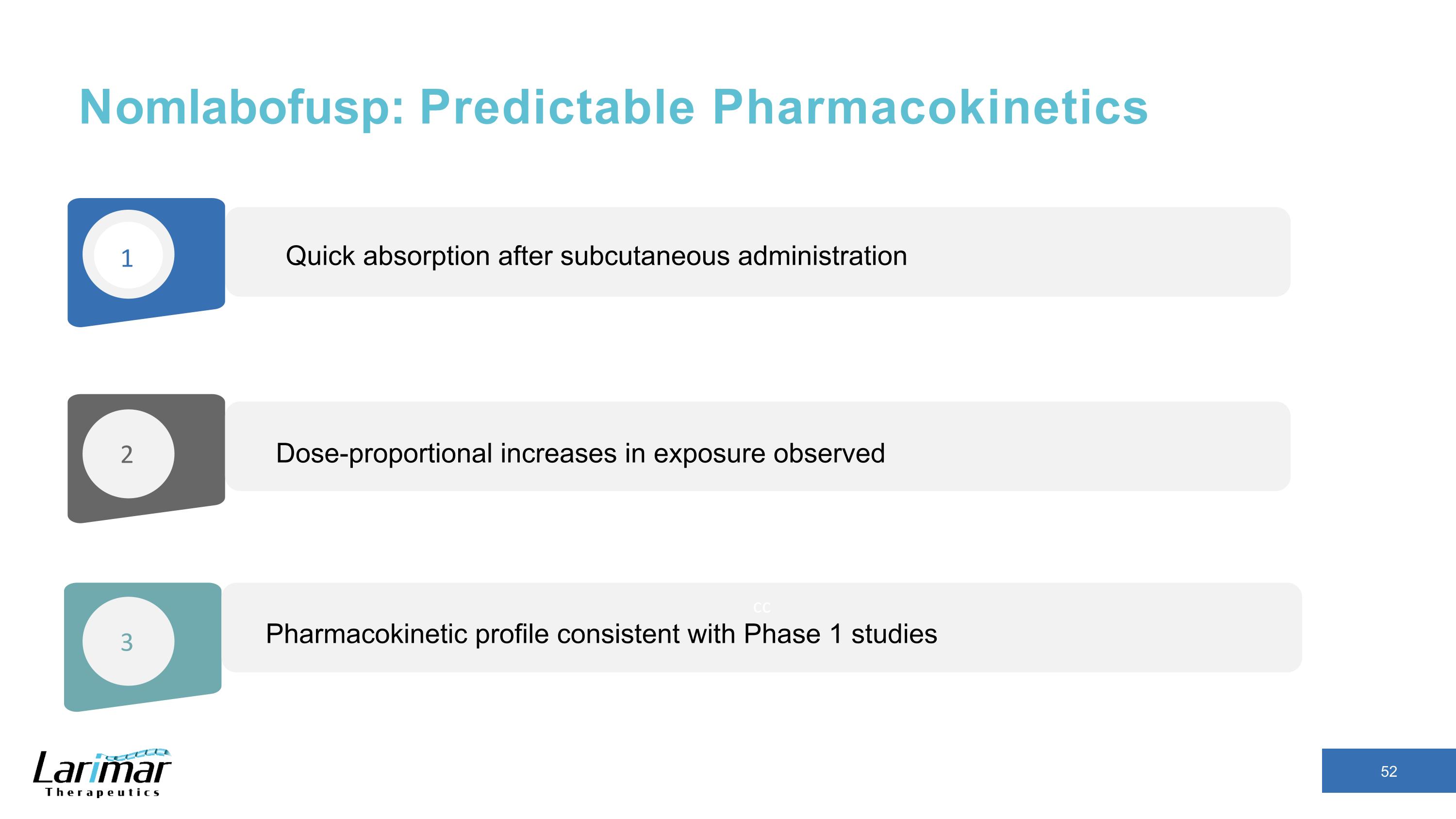
Nomlabofusp: Predictable Pharmacokinetics Quick absorption after subcutaneous administration 1 2 3 Dose-proportional increases in exposure observed cc Pharmacokinetic profile consistent with Phase 1 studies
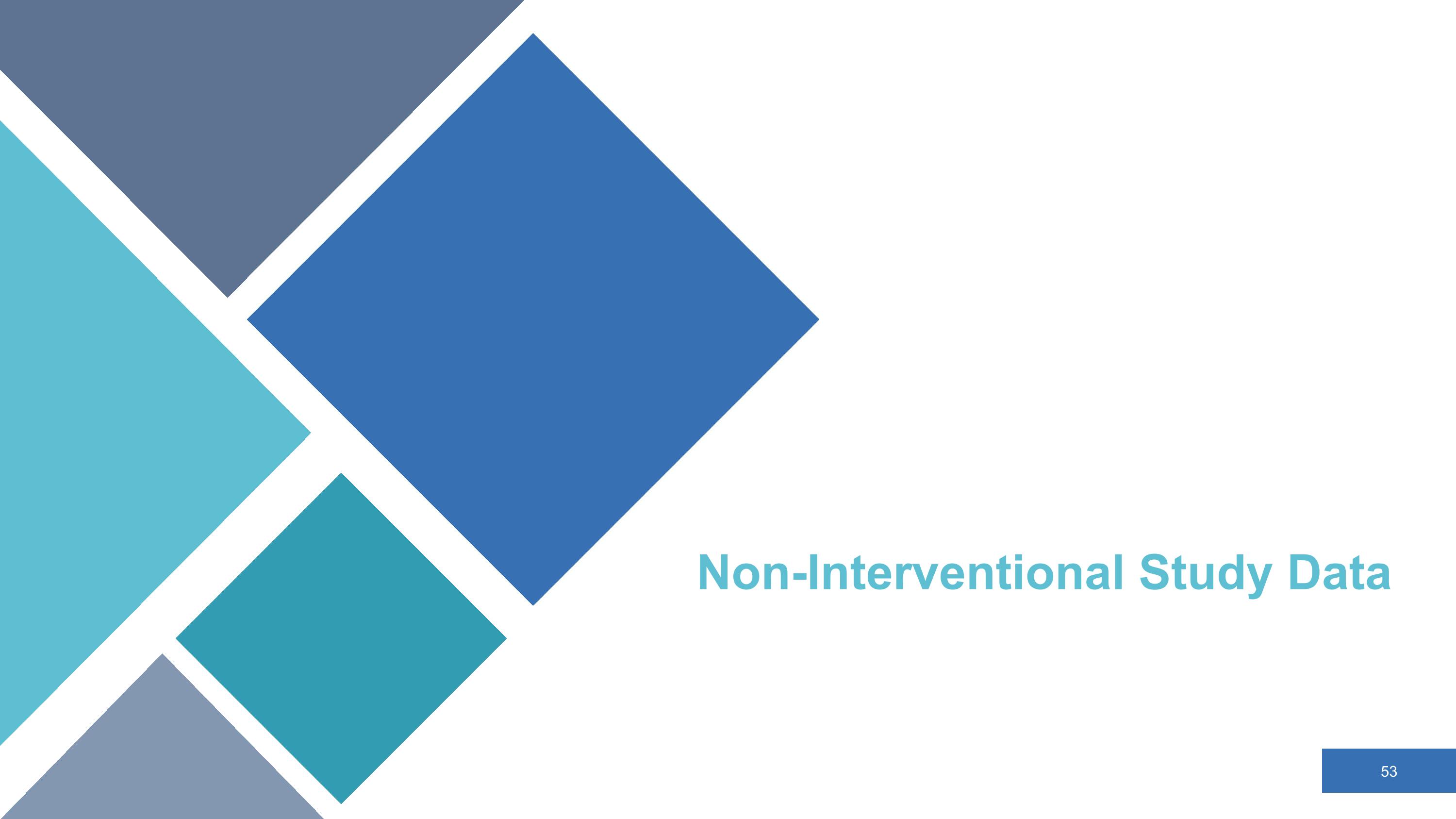
Non-Interventional Study Data

CLIN-1601-002: Top-line Non-interventional Study Results Non-interventional study measured FXN in homozygous healthy volunteers FXN concentrations were measured in skin and buccal cells from 60 homozygous healthy volunteers utilizing the same sampling technique and assay as clinical trials of nomlabofusp; FXN levels measured via detection of peptide derived from mature FXN; FXN concentrations normalized to total cellular protein content in each sample. 1. E.C. Deutsch et al. Molecular Genetics and Metabolism 101 (2010) 238–245. 2. Friedreich’s Ataxia Research Alliance Skin cells Buccal cells Median Frataxin Concentration (pg/µg) in Homozygous Healthy Volunteers (n = 60) Most patients with FA only produce ~20-40%1 of normal frataxin levels depending on the tissue, sampling technique, and assay considered Lower FXN levels seen with typical onset2 (5 to 15 years of age) Higher FXN levels seen with late onset2 (after 25 years of age) Heterozygous carriers who show no signs of disease have buccal cell FXN levels of ~50% of unaffected healthy persons1 [13.5, 18.6] IQR [6.2, 9.4] IQR

FDA START Pilot Program

Nomlabofusp Selected by FDA for START Pilot Program Highlights FDA commitment to augment formal meetings with more rapid, ad-hoc communications to accelerate program development of rare diseases START Pilot Program Support for Clinical Trials Advancing Rare Disease Therapeutics A new milestone-driven program launched by the FDA in September 2023 Designed to accelerate development of novel therapies intended to address unmet medical needs in rare diseases 7 novel drugs selected 3 products by CDER (nomlabofusp) for rare neurodegenerative conditions 4 products by CBER for cell and gene therapy FDA: Food and Drug Administration; CDER: Center for Drug Evaluation and Research; CBER: Center for Biologics Evaluation and Research; CMC: Chemistry, Manufacturing, and Controls CDER Selection Based On Demonstrated development program readiness (e.g., sponsors who demonstrate the ability to move the program towards a marketing application) Potential to address serious and unmet medical need in a rare neurodegenerative condition Alignment of CMC development timelines with clinical development plans Proposed plan where enhanced communication can improve efficiency of product development

FARA
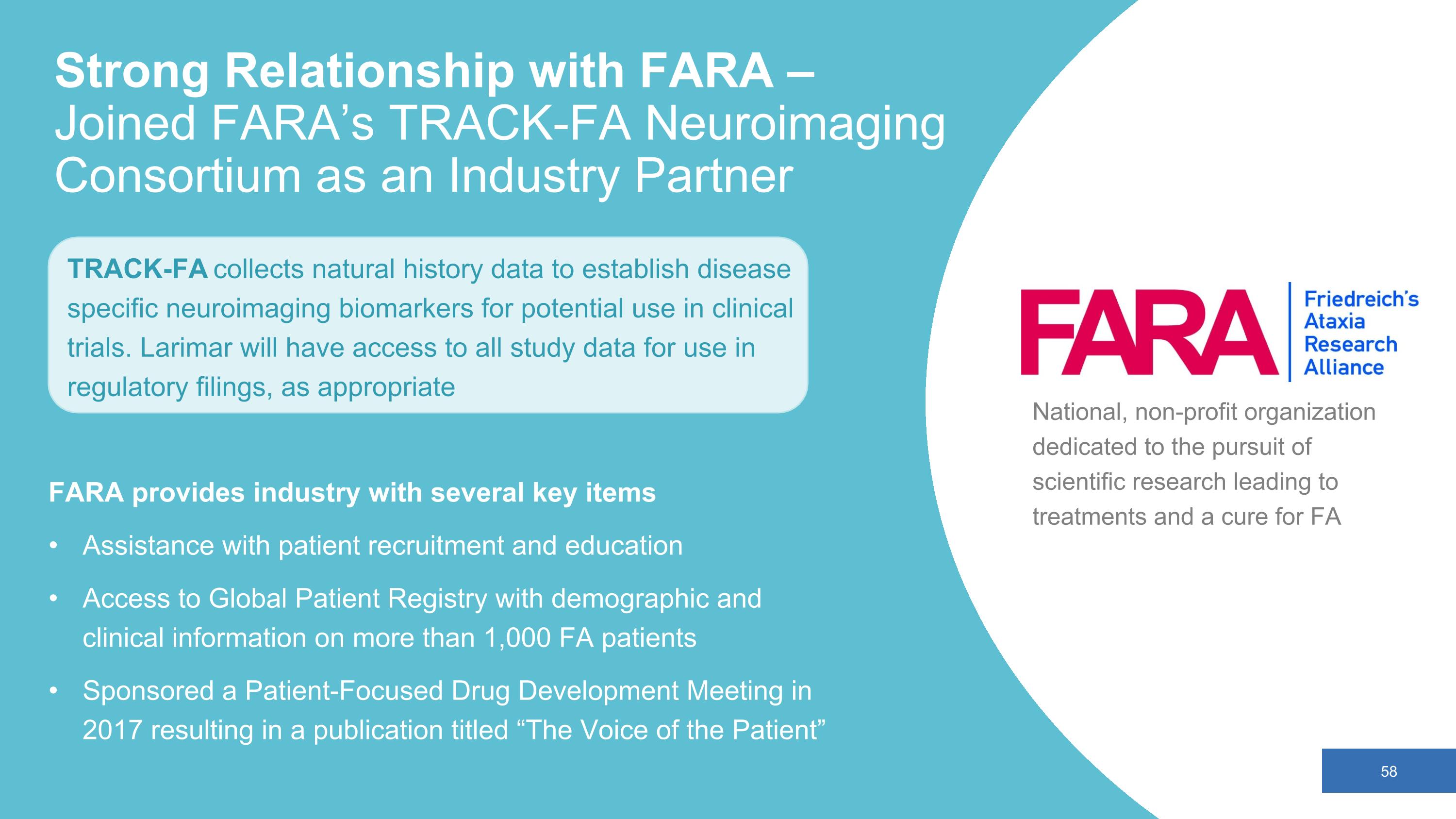
Strong Relationship with FARA – Joined FARA’s TRACK-FA Neuroimaging Consortium as an Industry Partner National, non-profit organization dedicated to the pursuit of scientific research leading to treatments and a cure for FA FARA provides industry with several key items Assistance with patient recruitment and education Access to Global Patient Registry with demographic and clinical information on more than 1,000 FA patients Sponsored a Patient-Focused Drug Development Meeting in 2017 resulting in a publication titled “The Voice of the Patient” TRACK-FA collects natural history data to establish disease specific neuroimaging biomarkers for potential use in clinical trials. Larimar will have access to all study data for use in regulatory filings, as appropriate